Bacteria
In contrast to plants and animals, bacteria's swift reproduction and biochemical effects help maintain the equilibrium of the living world. They can live just about anywhere, for which reason they are much more numerous than any other class of organism—actually, the most numerous on Earth. The entire ecosystem depends on the activities of bacteria, 3 and they impact on human life in a wide variety of ways.
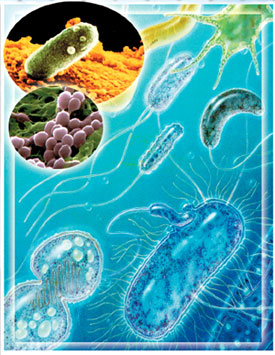 |
Species of bacteria come in very different forms. Some prefer oxygen-rich environments, while other, so-called anaerobic ones survive in oxygen-free ones. Some create their own food by means of photosynthesis, while others obtain nutrients by breaking down organic substances. Although bacteria consist of a single cell, their metabolisms may exhibit considerable differences. |
Their abilities reach way beyond present-day technology. Many of them can assume a new form every day, and their numbers can reach thousands in a matter of minutes. Some prefer oxygen-rich environments, while others can live underground without oxygen. Some obtain nutrients by performing photosynthesis, while others acquire energy by breaking down organic substances. Bacteria are generally assumed to be identical to one another, but when examined, they can be seen to actually consist of very different species.
Bacteria are known as prokaryotes in the living world. Their single cells contain a nucleus and free-ranging data banks of DNA. In their rather complex structures, these creatures possess a cell membrane and ribosomes. As you shall later see in detail, the majority of the vital functions of the living things on Earth depend, on the effects of these prokaryotic cells.
Bacteria possess two cell covers. Above the inner cell membrane is a cell wall consisting of proteins, carbohydrates and fats. In addition to their cell wall, some bacteria also have a protective capsule consisting of sugar molecules. The reason for these special coverings around the cell is to protect the bacterium from outside influences. The task of protecting a human being, undertaken by our skin, is assumed by the cell membrane in bacteria. However, the protective nature of the cell membrane is incomparably more powerful than that of human skin. Due to this resistant cellular structure, bacteria are able to adapt to very high or low temperatures, thrive beneath the soil, float through the air, live in toxic chemicals or at the bottom of the ocean, and even resist radiation. The bacterial cell membrane arises and generally consists of amino acids combined with sugar and lipid plus polysaccharide.
This complex polymer substance, known as peptidoglycan, is composed of two varieties of sugar. This structure's fine, complex covering varies according to species. It is so thin that it sometimes cannot even be seen under a microscope, because it consists of a web of fibrous structures just 1 to 3 nanometers in diameter. 4 A great many of the features possessed by bacteria are still unknown, because their minute size (around 0.001 millimeter, or 0.000039 of an inch) makes it impossible to study their internal structures properly.
Contrary to what evolutionists suggest, bacteria possess, not primitive structures, but very complex ones, which certainly proves that there is no spontaneous evolution.
 | |||
1. DNA, | 3. Flagellum, | 5. Capsule, | 7. Plasma membrane |
The single cell of a bacterium possesses a nucleus and free-foating DNA.. Its cell membrane and ribosomes are exceedingly complex. | |||
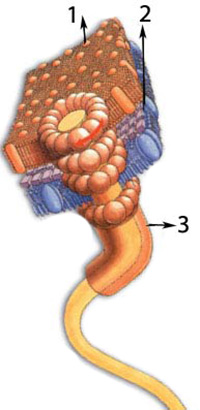 |
1. Cell membrane, |
In relative terns, the protective qualities of a bacterium's cell membrane are incomparably stronger than those of your skin. Bacteria are able to adapt to very different conditions, thanks to their resistant cell membranes. |
In addition to their cell membrane, bacteria also possess microscopic hairs known as cilia and an organelle called the flagellum, both of which lets them move. When these microscopic hairs are examined close-up, we encounter a real miracle. The flagellum—which has a different molecular structure from that comprising the bacterium's sheath and cilia—is the only organelle capable of truly moving backwards in the whole living world. The cilia hairs set up a wave motion towards from the root to the end, and thanks to the engine in its roots the fibers of the flagellum arranged in spiral (helezon) rotate like a propeller.5 The structure that enables the bacterium to move consists of two sections. In addition, instead of energy already present in the cell, a flow of acids in the cell membrane is employed as the energy source. The flagellum is a self-contained complex structure, whose organic structure consists of 240 separate proteins.
The complex structure seen in the flagellum is an example of irreducible complexity—a feature common to all living systems. The bacterium's membrane, the chemical engine mounted beneath it and the flagellum have all been created together so that the bacterium can move. Evolutionist scientists, who regard the bacterium as a simple living thing, are unable to account for its highly complex structure.
 |
Because of their resistant cellular structures, bacteria can adapt to high and low temperatures, can go underground, can remain aloft in the air and survive in harsh acidic chemicals and in the depths of the oceans. |
Under appropriate conditions, bacteria can double their numbers in 10 to 30 minutes. A single bacterium divides itself first in two, which two become four, then eight, and continues doubling in that way. Millions of bacteria can thus arise from a single one in 10 to 12 hours. Some varieties of bacteria are unaffected by temperature changes. They can live at -2710C (-455.8F) and adapt to environments that change from -1900C (66.2F) to +2500C (482F) in a matter of hours. Some species of bacteria are able to withstand 2,000 times the level of atomic radiation that would be fatal to humans.6 Some cause various diseases, while others serve vital roles in human and plant metabolism. Some are able to oxidize foodstuffs, by which means bacteria provide nourishment for other living things. Their millions of different functions lead to just one conclusion: This all shows that bacteria possess exceptionally detailed properties.
The evolutionist James A. Shapiro admits that that these detailed features they possess make bacteria complex living things:
Although bacteria are tiny, they display biochemical, structural and behavioral complexities that outstrip scientific description. In keeping with the current microelectronics revolution, it may make more sense to equate their size with sophistication rather than with simplicity. . . . Without bacteria, life on Earth could not exist in its present form.7
The Australian professor of biochemistry Michael Denton expresses the inconsistency and impossibility of evolutionist claims regarding a bacterium cell, with its various effects, forming as the result of a combination of coincidences:
The complexity of the simplest known type of cell is so great that it is impossible to accept that such an object could have been thrown together suddenly by some kind of freakish, vastly improbable, event. Such an occurrence would be indistinguishable from a miracle. 8
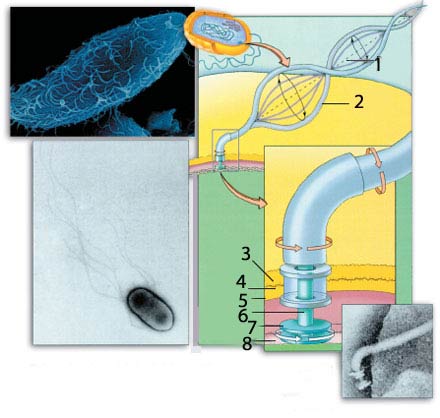 | |||
1. Axis of rotation, | 3. External membrane, | 5. Cell membrene, | 7. Rotating filament, |
Bacteria are equipped with various means of locomotion. Among these are the micro-hairs known as cilia. Another is the flagellum, the only structure in the living world able to literally move backwards. | |||
The so-called accidental coming into being suggested by evolutionists is of course impossible. As we shall soon be seeing in detail, a single bacterium's structure and features both disprove the claim that they could have come into existence spontaneously. These organisms, described as "simple" by Darwinists—perform, in the words of the British zoologist Sir James Gray—more activities than an entire laboratory:
A bacterium is far more complex than any inanimate system known to man. There is not a laboratory in the world, which can compete with the biochemical activity of the smallest living organism . . . 9
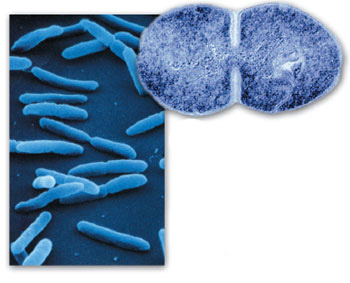 |
Under suitable conditions, bacteria can divide and double their numbers every 10 to 30 minutes. A single bacterium can produce millions more in just 10 to 12 hours. |
The bacterium's superior structure basically includes a DNA molecule and few organelles. Allah has installed this laboratory and its superior technical equipment and unbounded data into a single DNA molecule, a small part of a cell that is itself invisible to the naked eye.
Now let us examine the DNA molecule, the most important part of the complex bacterial structure.
One Fact Darwinists Cannot Explain: The Structure of Bacterial DNA
The information in the DNA in a single bacterium is equivalent to 20 novels of 100,000 words each. 10
Bacteria possess not only hundreds of different features, but also DNA that exhibits a superior Creation. There are 5375 nucleotides in the DNA of the smallest known bacterium, theta-x-174. (Nucleotides are the building blocks of the amino acids that regulate all inherited features in living things.) In a normal-sized bacterium, There may be up 3 million nucleotides.11 There are 5,000 genes in a single chromosome of the intestinal bacterium Escherichia coli, the subject of research and studies since the early 1990s. (Genes are special sections constituting the DNA belonging to a particular organ or protein.) All the features of the bacterium are encoded in these 5,000 genes.
 |
There are 5,000 genes in the chromosome of a single Escherichia coli bacterium. |
This coded information is essential to the bacterium's survival, and its slightest change may be fatal. The length of the helix that carries this information is 1,400 microns—in a cell only 2 to 3 microns in size.12 Don't forget that 1 micron is a unit equivalent to just 0.001 millimeter (0.000039 of an inch). This data chain, the product of a special Creation, is squeezed into an organism thousands of times smaller than itself. The processes that take place inside this marvel of Creation show the existence of a perfect organization and a conscious whole.
The anthropologist Loren Eiseley offers the following observation:
To grasp in detail the physio-chemical organization of the simplest cell is far beyond our capacity. 13
Again, such comprehensive data are necessary for the life of just one cell. Bearing in mind that bacteria are spread all over the world, it is astonishing that such information is arranged with the same care and in the same order in every one of them.
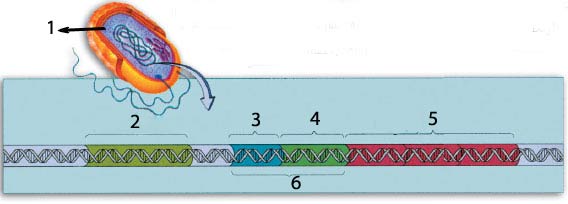 | ||
1. Bacterium, | 3. Regulator, | 5. Coding region, |
The length of DNA carrying data inside a bacterium 2 to 3 microns long is 1,400 microns. The processes that take place inside this marvel of Creation reveal a perfect organization. | ||
Could such a system come into being by chance? Of course not. Let us have a closer look at the DNA molecule in order to appreciate this better. Dr. Lee Spetner, an expert on biophysics and on the information contained within the bacterial genome, states:
The genome can hold a lot of information. The genome of a bacterium for example, is string of a few million symbols. The genome of a mammal has from two to four billion. If you were to print those symbols in a book in ordinary type, the book for a bacterium would have about a thousand page. . . All this information is in the tiny chromosomes of each cell. 14
Similarly, in his book Darwin Was Wrong, I.L. Cohen sets out the inconsistencies and impossibilities in the theory of evolution, and the impossibility of a bacterium's DNA coming into being by chance:
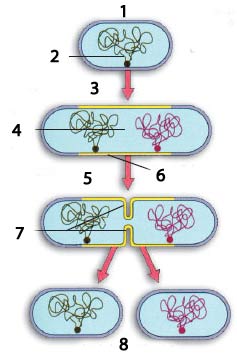 |
1. Young cell, |
Complexprocesses during cell division— such as DNA copying, copy production, transformation, cell division and chromosome division—are all flawlessly coordinated. |
Any species known to us, including the smallest single-cell bacteria, have enormously larger number of nucleotides than 100 or 1,000. In fact, single-cell bacteria display about 3.000.000 nucleotides, aligned in a very specific sequence. This means that there is no mathematical probability whatever for any known species to have been the product of a random occurrence or random mutations. 15
To replicate, bacteria employ various mechanisms. They may multiply by dividing into two, by turning into spores or by replicating sexually. These different reproductive processes are another proof of the bacteria's complex structure. Before the bacterium divides, first it divides into a structure known as a chromatin. The young bacteria make themselves ready to divide by reaching their full size within 30 minutes. During replication, an intelligently created system goes into operation, and the copying of the DNA that takes place is another example of irreducible complexity: For the system to function, all its components need to be fully formed and present at the same time. This totally undermines the basic claim of the theory of evolution, the idea of chance and gradual development. Recent research has revealed that this system is far more complex than had previously been thought.
For example, it has been shown that one reaction-regulator protein known as CtrA coordinates DNA replication within the cell of the bacterium C. crescentus. . CtrA, controls and alters a great many biological structures while carrying out cell division. Interestingly, CtrA is itself controlled by two elements known as phosphorylation and proteolysis. In other words, systems that appear to act independently in this system actually work together in a coordinated manner for the task to be performed. Complex processes such as replication of DNA and chromosome division must all be fully coordinated during cell division. The failure of any one system will lead to a halt in the cell-division process and the death of both new-formed cells. The presence of factors like CtrA to ensure coordination inside the cell is an important proof of the irreducible complexity of bacterial cell division.
We encounter a similarly complex structure in the bacterium E. coli. Its cell division system depends on a structure known as FtsZ—another example of irreducible complexity. E. coli too contains many side components linked to the system, and if any one is removed or its concentration levels altered, cell division will be impaired. Therefore, there is no way this system could have emerged gradually by means of natural selection.
The workings of many free-living bacteria shows the existence of a common nucleus cell-division system. In addition, a protein that separates the two DNA strands also forms part of this mechanism. 16
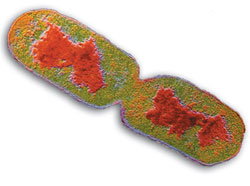 |
Division of an E. coli bacterium. |
As can be seen from these examples, bacteria are not the simple, primitive living things that evolutionists would have us believe. Like all "higher" living organisms, bacteria possess complex structures and mechanisms, and the processes that take place inside these single-celled creatures work in considerable harmony. Bacteria possess the ideal structures for the tasks they perform, and the evolutionists' error stems from their comparing a bacterial cell to a structure like the human cell, equipped for very different purposes. Only through such faulty comparison does the bacterial cell emerge as more primitive than the human one, because each system possesses the maximum complexity within itself. Each cell is merely differentiated according to the tasks it undertakes.
An article titled "The Artistry of Microorganisms" by Eshel Ben-Jacob and Herbert Levine, known for their studies into bacteria, appeared as the cover story of Scientific American magazine no. 1098 in 1998. They reveal another little-known miracle regarding bacteria and other single-celled organisms. Each of these living things, though invisible to the naked eye, possesses the most aesthetic appearance. Microorganisms such as diatoms, bacteria and plankton in their various shapes and colors turn the microscopic world into an art museum.
It appears that these aesthetic forms emerge not as the result of random coincidences, but according to various laws that apply within those creatures' structures. Eshel Ben-Jacob and Herbert Levine make the following comment:
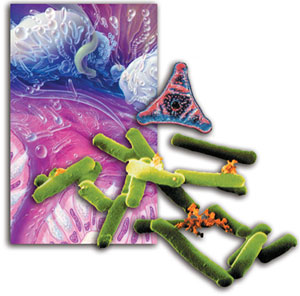 |
As the various microorganisms as they combine in many colors, symmetries and geometrical forms, they turn the micro-world into an art gallery. |
Simple bacteria, coping with adverse growth conditions, show unexpected sophistication. When examined closely this behavior is much more impressive. It seems as if the bacterial colony can not only compute better then the best parallel computers we have, but can also think . . . 17
As you have seen, bacteria and other microorganisms are living refutations of the myth related by the theory of evolution because it is unable to account for life in the first place. These organisms possess DNA, a data bank, but evolutionists are unable to explain where this came from. These organisms possess complex systems that function together, but evolutionists cannot explain how complex systems came into being. These organisms possess aesthetic shapes like snowflakes, but evolutionists are unable to explain the presence of attractive forms in these blind entities' structure. Despite the presence of so many mysteries and unanswered questions, evolutionists have produced myths and scenarios as a result of their dogmatic mindsets. Yet none of these bear any relation to the scientific facts. Without doubt, the intelligent artistry manifested in a single cell is a wonderful opportunity to see the miracles created by Allah, Whose omniscience endowed a microscopic structure with these wondrous features. One verse states:
He is the Knower of the Unseen, Whom not even the weight of the smallest particle eludes, either in the heavens or in the Earth; nor is there anything smaller or larger than that which is not in a Clear Book. (Surah Saba', 3)
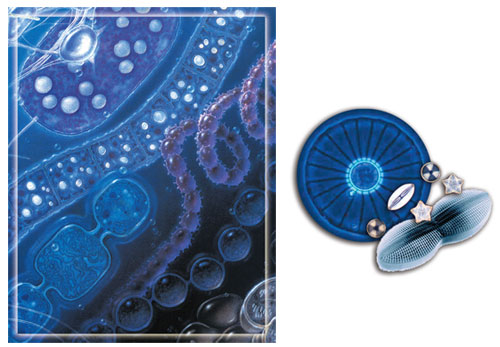 |
... He has no partner in the Kingdom. He created everything and determined it most exactly. (Surat al-Furqan, 2) |
Evolutionists, still unable to account for the structure of microorganisms, have no explanation to offer for the appealing aesthetic appearance in these creatures' structures. |
The Consciousness Exhibited in a Single Cell
Bacteria are present everywhere, all over the world. There may be billions of them, of millions of different species, in a single garden. Bacteria may display various effects depending on their locations, yet we remain generally unaware of most of them because only under an electron microscope can we see the superior intelligence manifested in the microworld.This tiny, yet widespread world that we cannot see directly consists of responsive entities that perform their responsibilities flawlessly, take precautions when danger looms, and carry out the most complex chemical processes. Each bacterium has been perfectly created as the work of Allah. Let us now examine the features of this superior Creation, under various headings.
 |
The micro world consists of seemingly conscious individual cells that flawlessly fulfill their own tasks, take precautionary measures when necessary or when danger looms, and which carry out the most complex chemical procedures. |
Bacteria Produce Spores to Preserve and Reproduce Themselves
 |
That is Allah, your Lord. There is no deity but Him, the Creator of everything. So worship Him. He is responsible for everything. (Surat al-An‘am, 102) It is Allah Who created the seven heavens and of the Earth the same number, the Command descending down through all of them, so that you might know that Allah has power over all things and that Allah encompasses all things in His knowledge. (Surat at-Talaq, 12) |
Bacteria take many different forms, whose appearances vary according to their environment. Many of them sporulate—that is, develop resistant forms known as spores, which can withstand excessive heat, cold or dryness. That's why some bacteria are so difficult to destroy. So what is this thing we refer to as sporulation?
Bacteria can thrive under very different conditions according to their species, but begin dividing when conditions are impaired. Under normal conditions, this division results in two offspring with exactly the same inherited features as the original cell. However, when conditions are disrupted or nutrients become limited, bacteria realize that the environment has become more difficult, and take precautions to ensure their descendants' survival. Division into two still takes place, but now, cells emerge that are not identical.
The reason for this inequality is the fact that only one of the two cells will live.
The larger, main cell absorbs its sibling, just like a protector. For 10 hours it will use all its energy to nourish it and permits the formation of a special protein sheath that will assist the protection of the smaller cell. In this way, the bacterium that develops inside one of the two parts forms a strong individual able to look after itself. The other dies, having given all its protective features to its sibling and turns into a protective sheath. This resistant structure that results is referred to as a spore.18 Therefore, in addition to normal division, bacteria are easily able to disseminate themselves all over the world by means of such spores.
Here we are faced with an example of a special Creation that single-celled living things possess to ensure their descendants' survival. A bacterium that senses that the prevailing conditions are not suitable for life immediately realizes it is time to divide and acts in a self-sacrificial manner. The main cell constituting the spore has no qualms about becoming a protein sheath. It cannot foresee the survival of its line or know beforehand how to ensure that survival. But can bacteria make such a decision? How is the bacterium selected that will have to die in the process? How does it bacterium know that conditions have worsened and that the other bacterium needs to be strengthened accordingly? By what division of labor, and most importantly, with what consciousness do they do this? The way that a living thing too small to be seen with the naked eye engages in such rational and altruistic behavior, acting with such astounding determination, is sufficient evidence that it was created. It merely acts on the inspiration placed in it by Allah.
 |
Bacillius species enable spore formation by surrounding their offspring cells in a protein sheath. The cells whose interiors are shown in green are those that will develop into spores. |
By this conscious process known as sporulation, bacteria can easily enter a wide range of habitats and spread across wide areas. Indeed, bacteria are even found in radioactive uranium mines! In much the same way that living bacteria have been found in bricks on the facade of the Temple of Luxor, built in Egypt 3,400 years ago, 200-million, 320-million and even 720-million-year-old living bacteria have also been discovered in blocks of rock salt. Bacteria have even been encountered at heights of 20,000 meters (65,620 feet) above sea level. 19
The most astonishing example is the bacterial spores from a 25-million-year-old fossil bee, trapped in pine resin, that have survived down to the present day. These spores, extracted under sterile conditions in the laboratory, were placed in culture and began growing and multiplying even after such an enormously long period of time. 20
The sporulation process is a method of protection employed by nearly all microorganisms. When conditions become unsuitable, some of them use sporulation to rise into the air to protect themselves among the clouds. The atmosphere contains a great many minute spores hoping to spread or seek protection. These spores that remain in the dry cold air live in a state of literal suspended animation, and descend to earth again with the rain produced by clouds. On their return, they may establish new colonies. Clouds are actually full of tiny, living microorganisms. As they crystallize and rise up with evaporation from the ground, they carry with them nutritional compounds such as methane, phosphate, carbon, and sulfur dioxide. 21
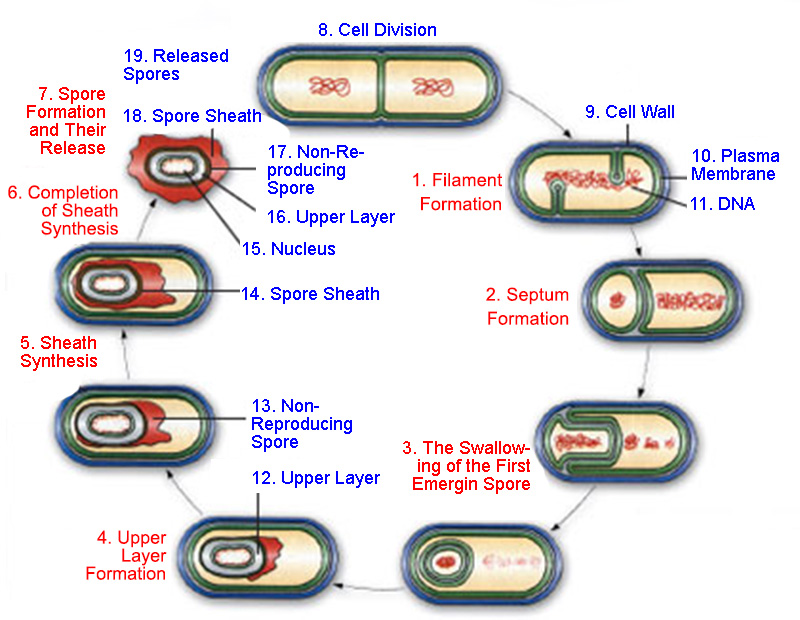 | |
1- Filament Formation 8. Cell Division | 10. Plasma Membrane |
The bacterium protects its offspring, or sister cell, in order to ensure the survival of its line, and sacrifices itself to that end. This process, known as sporulation, is illustrated in the above diagram. | |
Recent research has revealed another fact that has amazed scientists. One group of scientists researching in the Austrian Alps discovered colonies of bacteria living in the clouds. It was already known that bacteria were borne by clouds, but this new study also revealed that these colonies lived and bred in them. These same scientists also noted that these bacteria could cause rain or other climatic changes. It has also been reported that algae-like microorganisms that lived in the seas long ago played a regulatory role in keeping the climate stable by producing a gas called dimethyl sulphide (DMS). This gas enters into a reaction with oxygen at sea level and forms minute, solid particles. This sulfate layer concentrates water vapor and thus forms clouds. Finally, these clouds keep the Earth cool by reflecting solar radiation.22
 |
Living bacteria in the form of spores have been found on the exterior bricks of the 3,400-year-old Temple of Luxor in Egypt, and also in 720-million-year-old blocks of ice. |
In a statement to New Scientist magazine, Birgit Sattler of Innsbruck University said that it was previously thought that bacteria could not live at such elevations, and so these findings came as a complete surprise. The freezing cold, high levels of ultraviolet rays and lack of nourishment had led scientists to believe that life would not be possible up there. Yet it was thus demonstrated that bacteria can live in the clouds, as they do everywhere else.
 |
My Lord encompasses all things in His knowledge so will you not pay heed?’ (Surat al-An‘am, 80) |
Differently-shaped bacteria in 1,500 different sizes were identified in each specimen of cloud water taken from a meteorological station near Salzburg. According to scientists, high levels of bacteriological activity in clouds can affect the climate, depending on the their level of production or consumption of alcohol, organic acid and other substances. Scientists are continuing to investigate how bacteria live in the clouds, what they feed on and what compounds they produce. 23
How can a microorganism suddenly adapt to the highest levels in the atmosphere, where there are such very different conditions? How does it know that it needs to be protected there, and why does it select such a difficult and complex method as rising through the air? Even more interestingly, how does it manage to do so? How did it obtain the ability to control crystallization and air currents, and how does it know that the clouds will be able to protect and nourish it, and that one day when it starts raining, it will return to earth in a healthy state? How does this single-celled creature actually manage to do this? How do these microorganisms manage to do this, despite having totally different structures and features? Could a single-celled microorganism think of all this, learn by experimentation and inform all other members of its species? That being of course impossible, all these details once again point to the magnificent artistry manifested by Allah. It is Allah Who, in addition to creating the bacteria that carry out all these activities, also created the air that raises them, the clouds and atmosphere that shelter them, the rain that brings them back down, and the Earth that enables them to multiply and spread. For that reason, all these details have been created to be totally compatible with one another, and have remained in that state of equilibrium for millions of years.
Allah states in the Qur'an that:
In the Creation of the heavens and Earth, and the alternation of the night and day, and the ships which sail the seas to people's benefit, and the water which Allah sends down from the sky—by which He brings the Earth to life when it was dead and scatters about in it creatures of every kind—and the varying direction of the winds, and the clouds subservient between heaven and Earth, there are signs for people who use their intellect. (Surat al-Baqara, 164)
 |
In the heavens and Earth, there are certainly Signs for the believers. (Surat al-Jathiyya, 3) There are certainly Signs in the Earth for people with certainty. (Surat adh-Dhariyat, 20) It is He Who sends down water from the sky from which We bring forth growth of every kind, and from that We bring forth the green shoots . . . . (Surat al-An‘am, 99) |
Bacteria Perform Photosynthesis
 |
Antibiotics, which can sometimes be of vital importance in curing human diseases, are also produced by bacteria. |
We generally look at bacteria as germs that reproduce very quickly in our bodies or in food that has spoiled. Yet they also possess a great many features essential to life and with the organelles inside them, perform exceedingly important activities to maintain the equilibrium on Earth.
Bacteria play an enormously important role in supplying countless vital elements, from the air we breathe to the food we eat, and from the views around us to the antibiotics we use. In fact, every bacterium is an expert chemist, using nature as a laboratory. Chemical formulae are foreign to most of us, and indeed, it is impossible to understand chemical reactions without special training. Bacteria also deserve respect and amazement, for performing reactions of vital concern to our lives.
Even if we are even unaware of it, a chemical laboratory that works constantly and maintains our lives enfolds all of nature. This laboratory's most important activity is to provide oxygen and food for living things, and then to clean up waste products or produce new beneficial products that living things can use. During the course of this difficult and complex duty, many complicated chemical reactions are repeated, some of which are not yet been fully understood, some of which remain undiscovered, and only some of which have been replicated in modern laboratories.
 |
Bacteria exist unseen in countless aspects of your lifes, from the air you breathe to the food you eat and the views around you. This clearly reveals how important microorganisms are for our very existencel. |
Bacteria head the list of the chemists serving in this giant laboratory. The most important functions are carried out by these unicellular machines, regarded as simple and primitive by evolutionists. For bacteria, reactions that even the cleverest chemists cannot solve, and processes that not even the most advanced technology can replicate, are child's play. The scientists who discovered photosynthesis—the process of producing nutrients using carbon dioxide from the air and water—were amazed by it, and imagined that by decoding the system, they would find an answer to all the problems facing mankind. Yet decades have since gone by, and still the system is not fully understood and has not been imitated. However, this miraculous reaction is just one of the daily tasks that bacteria have performed , non-stop, for billions of years. With photosynthesis, these living things break down carbon dioxide in the atmosphere and give off oxygen, thus meeting life's most urgent need. Moreover, they possess the ability to use light energy from the Sun in order to separate carbon molecules from CO2. The way that carbon obtained in this way represents the basis of Earth's carbon-based life forms. As you know, life is based on carbon. All the basic organic molecules such as amino acids, proteins and nucleic acids are formed by carbon atoms combining with certain other atoms. No other element in nature can replace carbon. (For details see, The Creation of the Universe by Harun Yahya, Al-Attique Publishers Inc., Toronto Ontario, 2000) Therefore, Allah has made all of life dependent on organisms that perform photosynthesis. By Allah's will, the greatest share of this process belongs, to bacteria.
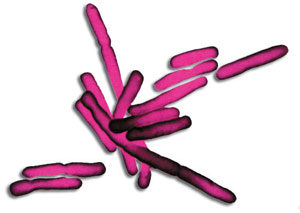 |
The processes carried out by bacteria constantly, every second, consist of reactions that sometimes not even the cleverest organic chemists can reproduce. Even the most advanced technology finds it difficult to understand these processes. |
By the phenomenon of photosynthesis, plants can make direct use of solar energy to turn out complex organic molecules for other living things to use. Such a transformation is necessary because human beings and animals lack any mechanism by which to make direct use of the Sun's energy. They can obtain that energy only in synthesized form as the result of photosynthesis performed by green plants and microorganisms.
Species known as cyanobacteria produce more than half of the oxygen in the atmosphere. 24 The mechanism these bacteria use is very similar to that used in plants' chloroplasts. The great majority of cyanobacteria contain only chlorophyll. The energy they produce from sunlight is stored in the form of simple sugars. The amount of sugar and oxygen formed by means of photosynthesis varies between an estimated 150 and 200 billion tons (330.700.000 million and 440.900,000 million pounds) a year.25 This sugar and free oxygen that form is essential for living organisms on Earth to survive and grow, and also to respire.
Cyanobacteria assume an important role in stabilizing the concentration of oxygen in the atmosphere. These bacteria are very small in size, but their numbers are very great. There are more than 100 in a liter of water, and they represent 10% to 20% of the productivity of the oceans. Despite being too small to see, they exist over a large part of the world. Their enormous numbers are of the very greatest importance due to the energy they produce with photosynthesis.
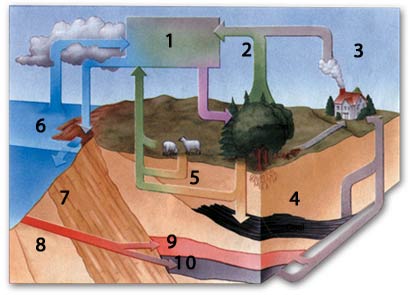 | |
1. Air (CO2), | 6. Carbon dioxide dissolved in water, |
The carbon cycle on Earth takes place thanks to bacteria. | |
The particularly complex and delicate mechanism of photosynthesis is is not yet fully understood. Also, the process is one of the best examples of irreducible complexity. In other words, in order for photosynthesis to take place, a great many special structures have to be present at the same time and work together in a coordinated way. For example, in photosystem I, which evolutionists maintain to have evolved first, reaction centers and antennae were brought together to catch the rays from the Sun. Photosystem I had been regulated to trap only a particular wavelength of light. Stimulated by photons with a wavelength of 700 millimicrons, the antennae contain trapping chlorophyll molecules known as K1 a1. To support these antennae, there are also assistant pigments such as carotenoid.
Moreover, photosystem I is a joint activity, performed by an electron chain ready to transfer the trapped energy, a kind of power station used to break down this energy and water, and a separate chemical factory taking in carbon from the air with substances separated from water to produce nutrients. The lack of just one of the components making up this system, still not yet fully understood, would render it totally useless.
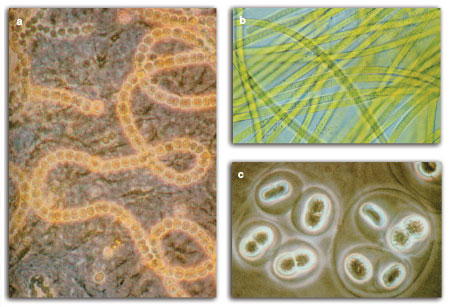 |
The pictures show three types of cyanobacteria. (a: Nostoc, b: Oscillatoria, and c: Gleocapsa). These bacteria, which live in clean waters, have exceptionally complex chlorophyll. Thanks to these systems, which are almost as complex as plant chloroplasts, cyanobacteria perform the process of photosynthesis in nature. Nostoc cyanobacteria also play an important role in nitrogen transformation and the "fixing"of atmospheric nitrogen. |
For example, energy cannot be absorbed without antennae. Without the electron chain, H2O atoms could not be broken down. If the assistant pigments failed to share the high electrical burden, then intense energy levels would break down the entire structure to. The subject can be more clearly understood if we think of this structure as a factory and the electrical power station that runs it. The factory cannot produce anything without electricity, raw materials and workers. Similarly, the lack of just one of these elements will rule out any possibility of photosynthesis at all. Neither would the components coming into being one by one be any use. Even if we assume for a moment that the very complex photosynthesis antennae did come into being by chance, clearly they would be unable to transmit the trapped energy and be torn apart. The Turkish evolutionist Professor Ali Demirsoy comments:
Photosynthesis is a most complex phenomenon, one which appears impossible to emerge in the organelle inside a cell. That is because it is impossible for all the stages to form at once, and meaningless for them to do so one by one. 26
And He has made everything in the heavens and everything on the Earth subservient to you. It is all from Him. There are certainly Signs in that for people who reflect. (Surat al-Jathiyya, 13)
In conclusion, this system could not come about by stages as evolutionists maintain. Its irreducibly complex structure requires all its components to be present and fully functioning at once. This, in turn, shows that the mechanism was flawlessly created at a single moment with all its separate parts.
A process like photosystem, which cannot be replicated by modern-day technology, must have been created as a whole. Not just the system that makes photosynthesis, but the Sun ideally suited to it and the atmospheric environment was also created as a whole, with the same superior knowledge and intellect.
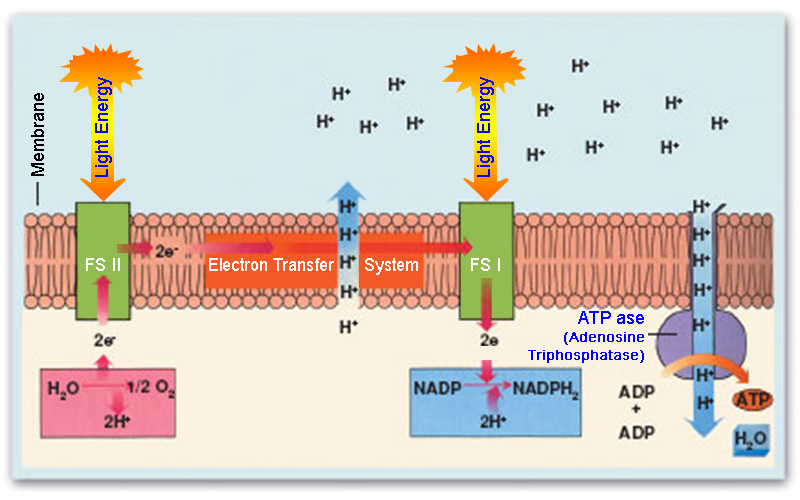 | ||
1. Membrane | 3. FS I | 5. Electron Transfer System |
How solar energy is used by cyanobacteria to form ATP and NADPH2. When light arrives, electrons depart from photosystem I and photosystem II. Both photosystems remain without electrons. The electrons departing photosystem I are used for the reduction of NADP and NADPH2. At this point, the electrons departing photosystem II reach photosystem I by means of the electron transport system. The force that develops in the electron transport system permits the synthesis of ATP from ATP (adenosine triphosphatase). Photosystem II, left with no electrons, obtains these from water (H2O) molecules. This oxidation in water permits release of oxygen O2 gas. | ||
The explanations made by the proponents of the theory of evolution regarding this mechanism are exceedingly illogical, often ridiculous. According to evolutionist claims, primitive bacteria in the primitive environment began using up the foodstuffs around and suddenly, somehow began to produce their own food. Billions of years ago, an imaginary bacterium, discovered how to obtain food from the Sun via a mechanism that mankind has been unable to do even with the advantage of 21st century technology. This most talented bacterium established the basis of photosynthesis, and by allegedly evolving in some manner, produced plants that mde possible the free oxygen and foodstuffs on Earth. Thanks to this fortuitous discovery, the wide range of other species assumed their present forms. The fact is that a single cell possessing a system capable of providing such basic needs as food and oxygen essential for human life, the development of countless chemical processes inside it and its being a part of the ecological balance can never be explained in terms of chance and unconscious events. Allah has specially created these living things to carry out this important process. Bacteria prove the existence of a superior power that created them to be flawless, in other words of Allah. The superior intellect and artistry of Allah are manifested in the functions they fulfill. All these, of course, are just a few of the examples that show the impasse facing the theory of evolution, how it is entirely based on false evidence, as well as the absolute existence of Allah.
Bacteria Perform the Nitrogen Cycle on Earth
In the same way that living things require oxygen and CO2 in order to survive, they also need nitrogen (N2) to grow. Nitrogen is present at a level of roughly 15% in the structure of the nucleic acids, proteins and vitamins in the body.27 It represents one of the ba sic building blocks of life. Around 78% of the atmosphere consists of nitrogen gas, but living things cannot absorb this nitrogen in the air, despite their need of it. It must somehow be turned into a form that living things can use, and then be recycled into the atmosphere so that it does not run out.
This need too is met by microscopic bacteria.
 | |
The nitrogen cycle that bacteria carry out with the help of plants on Earth. | |
N2 + 8H+ + 8e- + 16 ATP = 2NH3 + H2 + 16ADP + 16 Pi
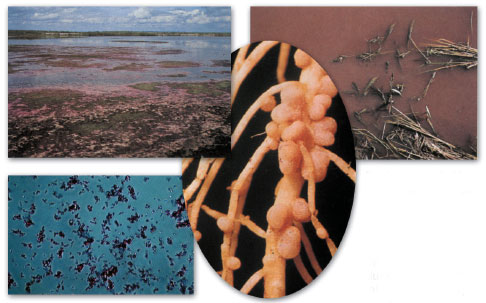 |
For example, the nitrogenase enzyme complex that bacteria use during this process is exceptionally sensitive to oxygen. When deprived of oxygen, it stops its activity, for which reason proteins enter into reactions with iron compounds. This represents no problem for anaerobic bacteria, which are capable of living without oxygen, but a major hurdle for bacteria such as cyanobacteria that produce oxygen by photosynthesis. and azotobacter that live freely in the soil. However, these other bacteria have been equipped with various mechanisms to resolve this difficulty. For example, azotobacter species possess metabolisms with the highest known respiratory rate among all organisms, thus keeping oxygen levels in the cells low and protecting the enzyme. In addition, azotobacter species produce high levels of extracellular polysaccharide, compounds consisting of multiple sugars and especially starch used in the formation of the cell wall. Bacteria preserve water in the sticky fluid formed by these compounds and restrict the level at which oxygen is disseminated in the cell. Bacteria like Rhizobium that fix nitrogen in plant roots, possess molecules such as leghemoglobin that consume oxygen. Leghemoglobin serves the same purpose as hemoglobin in animals, regulating oxygen for the node tissues. Interestingly, leghemoglobin is found only in the root nodes and produced only after a plant-bacterium relationship is established. Bacteria that live alone or plants that live without bacteria are unable to manufacture it. 28
 |
Bacteria like Rhizobium that fix nitrogen in plant roots, possess molecules such as leghemoglobin that consume oxygen |
The enzyme nitrogenase, responsible of preserving the nitrogen cycle, breaks down when deprived of oxygen. In that case, the systems that prevent oxygen from reaching the enzyme, and the organisms that produce them must have come into being at the same time as that enzyme. Otherwise, the moment that the enzyme nitrogenase formed, oxygen would have broken it down. The theory of evolution is unable to admit this, because it holds that organisms can form only through gradual mutations. Again according to that theory, either the enzyme nitrogenase or the systems that consume oxygen must have appeared first—yet that illogical sequence that permits no system at all to form. No system can control oxygen in the absence of the enzyme nitrogenase.
When these bacteria die and are broken down, ammonia is released. At the same time, saprophyte bacteria break down proteins in animal and plant remains and turn them into ammonia. The ammonia, formed in the soil in this way, is converted in the same way into nitrite by nitrite bacteria, and then into nitrate by nitrate bacteria. By this process, known as nitrification, the nitrogen cycle is completed.29 Nitrate is a form of nitrogen that plants can absorb. This nitrate also reaches human beings and the animals that consume plants for food. By these means, therefore, the needs of all living things are met.
Creating artificial fertilizer containing nitrates gave rise to one of the major branches of industry. Combustible hydrogen, used during this dangerous and complex process, is heated at very high pressure. Although chemical factories spend great efforts on this costly and dangerous work, bacteria perform the same process at room temperature and normal atmospheric pressure. Some researchers now think that they have unraveled part of the secret behind bacteria's success.
Another group of scientists have adopted bacteria as a model in producing free hydrogen, a clean and cheap fuel. According to an article in the 8 October 2001, edition of Nature magazine, scientists believe they have imitated bacterial enzymes that turn cheap acids into hydrogen. Unlike other fuels, hydrogen does not harm the environment when burned. Thomas Rauchfuss, and his colleagues in a research team affiliated with Illinois University, think they will be able to copy and use these secret formulae of bacteria. 30
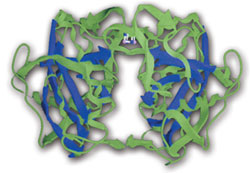 | 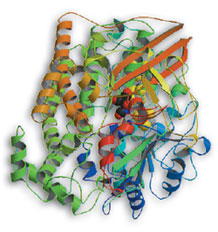 |
Bacteria need the enzyme nitrogenase to carry out nitrogen transformation. | The enzyme hydrogenase |
These bacteria possess hydrogenases, enzymes able to produce hydrogen from acids. Scientists are trying to produce systems that can replicate this perfect mechanism. But having striven in the same way for years to replicate the photosynthesis process performed by bacteria, they have not yet achieved any success. Evolutionists regard bacteria, as primitive, yet their complex systems that have proved impossible to duplicate despite all the means of present-day technology. Bacteria have possessed secrets that have guaranteed life on Earth for billions of years. The reason is that they are the flawless work of Allah, with His superior intellect. Allah displays His astonishing artistry in such a magnificent ways so that human beings may witness it, and reflect on what they see.
 |
Thanks to bacteria, nitrogen is transformed by plants into molecules that human beings and animals can use plants as food. Therefore, one of the animals' most basic needs is ensured by the workings of bacteria. |
In order for plants, and therefore for all other living things on Earth, to survive, there have to be bacteria to maintain the nitrogen cycle. If the nitrogen taken out of the soil is not immediately replaced, life will soon come to an end. This process carried out by bacteria adds some 50 tons (110,200 pounds) of nitrogen to the soil each year.31 Since all organisms directly or indirectly depend on photosynthesis to obtain energy, they also depend on nitrogen, the most fundamental element, for photosynthesis to take place.
These examples send out a clear message. Nitrogen must be turned into a specific form for the nourishment of all living things. That transformation must cover the whole world and be supported by different features. When we see in nature is not a flawed system that has emerged tshrough blind chance, but one that has been created right down to the finest detail, in the light of a specific objective. Bacteria have assumed the main role in this process, as living machines especially created for the job, rather than as primitive forms that emerged as the result of random evolution.
Rather than invent illusory scenarios based on their outdated ideology, evolutionists now need to provide scientific explanations of how such complex creatures and variety came into being at the same time, equipped with such highly advanced information. Yet since they can never give such an explanation, it is amazing that they still persist in making their claims. Allah reveals this about such people in the Qur'an:
ŞThen inquire of them: is it they who are stronger in structure or other things We have created? We created them from sticky clay. No wonder you are surprised as they laugh with scorn! (Surat as-Saffat, 11-12)
 |
Hydrogen-powered cars |
Bacteria Produce Foodstuffs through Fermentation
 |
Oxygen-breathing bacteria obtain energy by breaking down organic compounds in their environment. This process, known as fermentation, gives rise to acids as well as wine and various delicious foods. |
Did you know that the yogurt and cheeses you eat are the work of bacteria? You may be unaware that a great many foods on your table are provided by bacteria, ready-made on your behalf. The cheese you eat is prepared by bacteria, as well as the pickles that go with it so well.
You have already seen that species of bacteria can live in a great many different environments and conditions. Basically, all that the bacteria that produce cheese and yogurt really want is to obtain energy for carrying on with their lives. For them, the closed environment they live in is important, because these species of bacteria breathe without oxygen. To put it another way, while other bacteria obtain energy by breathing, these bacteria obtain energy by breathing by breaking down organic compounds around them and as a result, release a great many substances. These byproducts acidify the foodstuffs containing these bacteria, or else transformed them into alcohol, or else bubbles of carbon dioxide are generated. In this way, vegetables become pickled, and sugars are transformed in a process known as fermentation. 32
Fermentation has many more uses than just giving us delicious things to eat.
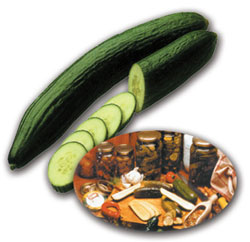 |
Food quality changes thanks to bacterial activity. In other words, fermentation turns a cucumber into pickle. |
Once again, bacteria perform a most important essential function, by increasing the variety of foodstuffs by means of fermentation. At the same time, during the fermentation process, bacteria release various minerals and synthesize vitamins that are exceedingly beneficial, which is why yogurt and cheese are so good for us. It is also thanks to bacteria that these products provide therapeutic effects on the intestines and a great many digestive disorders, helping to maintain the body's equilibrium.
For example, the foods recommended for cholesterol problem are generally fermented ones. The reason for this is that microorganisms are able to regulate the level of cholesterol in our bodies. 33
Bacteria make enormous efforts on our behalf. In fact, all they want is to be able to survive with the means in their possession. While these microorganisms live on through this magnificent equilibrium created by Allah, they also aid human beings in a great many ways. The way that a bacterium produces foods so beneficial for us shows just how important that equilibrium is. There is no doubt that a bacterium did not have to live in our food, obtain energy from it or prove harmful or beneficial to us. We might never have been aware of these bacteria, a vital component of our lives. In fact, Even if you are not aware of it, we take a great many bacteria into our bodies through foodstuffs. However, even as bacteria meet their own needs by entering the food we eat, they also create brand-new and health-giving substances for us in a way impossible by any other means. Behind the benefits imparted by bacteria is the obvious fact that Allah has created immaculate and very different systems to let us see the evidence of His superior and incomparable Mind.
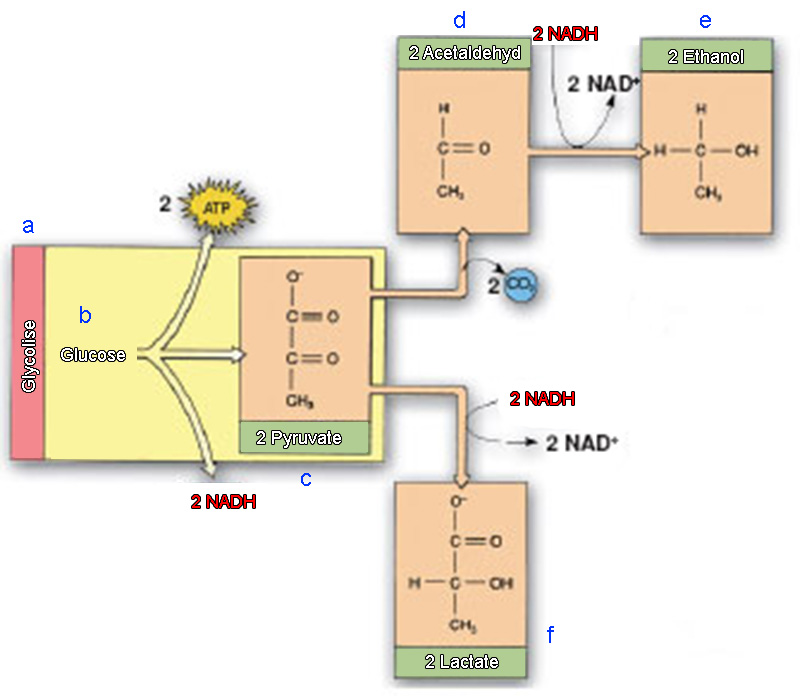 | ||
a. Glycolise | c. 2 Pyruvate | e. 2 Ethanol |
During alcohol fermentation carbon dioxide is released from piruvic acid and the final product emerges as two carbon ethanol (ethyl alcohol) molecules. In lactic acid fermentation NADH transfers hydrogen to piruvic acid and lactate is the final product. Two ATP molecules are acquired in both fermentation processes. | ||
Other Activities of Bacteria
 |
Bacteria separate iron dissolved in water and concentrate it. This iron later turns into iron strata in the ocean floor and over the course of millions of years gives rise to the iron beds in mountains. |
There are very definitely other important features in bacteria, which make such a major contribution to life on Earth by making photosynthesis, protect our bodies, give rise to the most important life cycle on Earth, but which are so small as to be invisible to the naked eye, addition to displaying the superior intellect and artistry in their Creation. Bacteria also represent the source of the world's iron reserves, and even of the iron in our bodies.
Some bacteria possess the ability to separate out the iron dissolved in sea water, consuming the iron molecules and concentrating them in their own bodies. The iron thus concentrated then forms layers on the sea bed. Over the course of millions of years, these layers are raised up into mountains and form enormous veins of iron oxide. When these layers are dug up, a large quantity of iron molecules become released into the air. Then, all unknowingly, we breathe in this iron dust—absorbing molecules of the greatest importance to us. Because of the tiny iron molecules that enter our bodies, our red blood cells can produce the hemoglobin that carried oxygen to every cell in our bodies. 34
This chemical effects of the bacteria that form this underground resource is not limited to isolating iron. Oil, one of the world's vital needs, is also largely the product of bacteria. As with the process of fermentation, anaerobic bacteria (which breathe without oxygen) meet their needs for energy by breaking down the organic compounds around them, leading to organic deposits that formed underground millions of years ago transforming into crude oil.35 35 The idea that bacteria permit the production of oil may come as a surprise but the way that these microorganisms work non-stop for several million years 36 is actually evidence that they were created in the interests of human beings, meeting needs whose lack would leave us quite helpless.
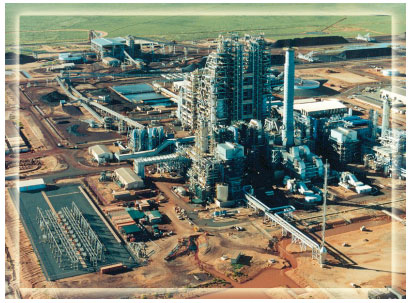 |  |
And the Earth–We spread it like a carpet and how well We smoothed it out!(Surat adh-Dhariyat, 48) | |
The iron that forms as a result of the activities that bacteria have been carrying out for years is of great importance for mankind. Without these activities performed by bacteria, it would be impossible for us to obtain substances essential to us. The foods and minerals needed by plants and animals which live in a state of suspended animation in lakes throughout the winter as they return to life are prepared by the activities of bacteria. Throughout the winter bacteria break organic wastes that sink to the bottom into minerals and prepare food for the re-awakening of nature in the summer. | |
Recent research on the ocean floor has revealed another hitherto unknown fact about bacteria. As we know, bacteria represent the main link in the food chain by means of photosynthesis, nitrogen fixation and fermentation. Studies carried out on the ocean floor 300 meters (984,25 feet) beneath the sea have revealed another hitherto unknown fact about bacteria. Newly discovered bacteria live hundreds of meters beneath the sea, feed on rocks in the sea bed, and there perform a fundamental food function for life.
 |
Thanks to the superior mechanisms they possess, bacteria carry out a great many miracles that human beings are unable to, and the secrets of which they are even sometimes unable to penetrate. The role they play in the formation of oil clearly demonstrates this fact. |
Hubert Staudigel, of a team affiliated to the University of California Scripps Institution of Oceanography, stated that the sea bed was covered with these bacteria, and that no location was without them.
These organisms that break down rocks contribute to the food chain in the sea by breaking down necessary chemical substances, performing a fundamental function in maintaining life at the bottom of the ocean. 37
Bacteria in lakes are also responsible for preparing essential minerals and nutrients over the summer months. As plants and animals in lakes become active again, having lain dormant throughout the winter, all the minerals and nutrients they now require have been released by bacteria over the cold months. Over the winter, bacteria break down organic wastes—dead animals and plants and other waste products that sink to the bottom—into their component minerals. They thus clean the lakes of debris, while various mineral products collect at the lake bottoms.38 When living things wake up in the spring, they find their nutrients ready and available. Bacteria perform not only a kind of spring cleaning, but prepare sufficient food for the life that re-awakens every spring. Allah, Who has unconditional mercy on all the living things He creates, has made bacteria responsible for sustaining the countless different species in lakes. Bacteria are quite unaware of the benefits they impart to other organisms, nor do the living things that come to life again in spring wonder as to the origin of their nutrients. They merely submit to Allah, their Creator.
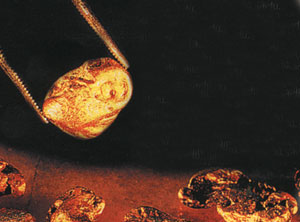 |
Bacteria living in gold beds accelerate the sedimentation of microscopic gold particles as the feed on rocks, and give rise to gold deposits underground. Allah has made bacteria a means whereby gold, which adorns our lives, comes into being. |
Perhaps the most valuable commodity that underground bacteria help isolate is gold. 2 miles (3.2 kilometers) beneath the surface, these bacteria live in veins of gold and work like alchemists secretly manufacturing gold. As they feed on rocks, they accelerate the sedimentation of microscopic particles of gold under the ground.39 This process is very slow; in fact, the vital functions of bacteria underground are much slower than those of bacteria on the surface.
A normal bacterium divides every 3 to 4 hours, whereas these underground bacteria divide once every 100 years! These organisms can live for millions of years without having any contact with the surface40 —major evidence that these bacteria in question were specially created to refine gold, an instructive phenomenon that shows Allah's flawless Creation. Bacteria change their rate of reproduction according to their environment. Certainly no single-celled creature behaves in a conscious manner. It is Allah, the Omniscient, the Most Intelligent of all intelligent beings, Who inspires their behavior and calculations.
Bacteria in Beneficial Symbiotic Relationships With Other Living Things
By entering the bodies of a great many living things, including human beings, bacteria provide direct or indirect advantages for life. They even serve a purpose in the digestive systems of termites, some of the smallest insects that can be seen with the naked eye. Termites cannot digest cellulose on their own. They need bacteria to help them in this process, and there are some 2.7 million bacteria in the stomach of a single termite.41 In the same way, bacteria also permit ruminants—cows and other four-footed ungulates—whose metabolisms are also unable to digest cellulose, to do so successfully.
Bacteria live everywhere in the healthy human body. According to various estimates, there are some 10 million bacteria on every square centimeter of human skin. For example, we know that 80 different species live on the tongue alone, and that the number of bacteria expelled from human body ranges between 100 billion and 100 trillion. Some 10 billion organisms live on a square centimeter of the human intestine. 42
 |
Bacteria facilitate digestion in animals that chew the cud, whose metabolisms are unable to digest cellulose. |
Professor of microbiology Mark Pallen, of Queen's University in Belfast, says this about the bacteria in the healthy human body:
There are some 80 different species in the mouth alone. Research performed at the Jouy-en-Josas Ecology and Physiology Laboratory in France revealed 80 kinds of bacteria in the intestines. It is difficult to give an exact figure for the micro-organisms living in the body, but we may say that some 200 kinds are involved in keeping the body healthy. 43
This number of 200 that Mark Pallen cites is the number of species of microorganisms in the body. Their total numbers are in the millions. Each species of this enormous community possesses various functions in the body, of which we generally live completely unaware. But they are active every hour, every minute, on our behalf.
Many living things enjoy such symbiotic relationships with bacteria. Let us give a few examples.
Examples of Bacteria's Shared Lives
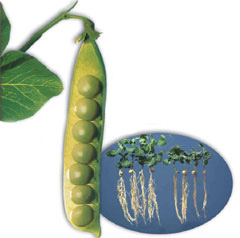 |
The symbiotic bacterium has found shelter for itself in bubbles that emerge in pea roots. In return, the plant obtains a never-ending store of nitrogen. |
Bacteria enter into mutually beneficial relationships with plants as well. For example, bacteria with nitrogen-binding properties live in the roots of clover and of peas. Any plant deprived of nitrogen will die sooner or later. For that reason, the bacteria living in nodules in the roots are so important. Why do these bacteria prefer peas? The reason lies in chemical communication among the two species. Symbiotic bacteria encourage the formation of small nodules in the roots by activating certain genes in the plant. The bacteria then use these nodules as shelters. In return, the plants acquire an endless supply of nitrogen. 44
Another symbiotic relationship exists between the puffer fish and intestinal bacteria. Porcupine fish possess an unusual poison known as tetrodoxin, which is produced by the bacteria living in the fish's intestines. Although the greater part of this toxin is found in the liver, intestine and other internal organs, it spreads all through the fish's flesh. Some of it even enters the muscles. Anything that eats a porcupine fish is therefore exposed to a grave danger. Predators aware of this danger avoid eating it.45 In turn, this contribution from the bacteria prevents them from falling prey to other fish.
Of course, the poison that poses such a threat to other fish inflicts no harm on the porcupine fish itself, despite being spread throughout its entire body. This shows a flawless structure specially created by Allah for the fish's protection. That other fish are aware of the danger and try to avoid the porcupine fish, and that the bacteria have developed such a defensive weapon, show that Allah created these two species to be compatible with one another, is an example of His superior Creation.
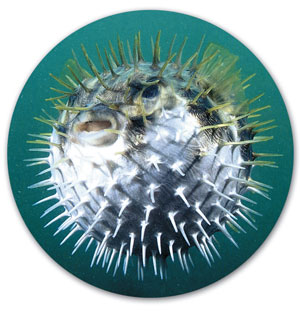 |
Bacteria living in the intestine of the porcupine fish produce a toxin that spreads as far as the fish's muscles. This poison protects the fish from enemies, but does the fish itself no harm. |
Bacteria also enjoy an interesting relationship with tube worms, a single gram of whose inner tissues can contain 100 billion bacteria. The red hairs of tube worms are filled with blood carrying not oxygen, but hydrogen sulfate for the bacteria to feed on. In return, the bacteria oxidize the hydrogen sulfate, and turn the resulting carbon dioxide into carbon compounds that nourish the worms.46
The relationship between the two is based on an exchange of nourishment: While the worm feeds the bacteria, the bacteria produce food for the worm.
Another marine worm, Riftia pachyptila, needs bacteria for digestion. This species of worm has no digestive system of its own.
It used to be thought that this invertebrate lacking a digestive system absorbed organic substances dissolved in sea water by means of its skin. However, it was soon realized that the surface area of its skin is too small in proportion to its volume for it to possibly feed in this way. In 1981 the astonishing discovery was made that the worm actually fed in a normal way, but that its digestion was actually performed by bacteria. The cooperation between the worm and the bacteria is indeed most practical. The water the worm takes in through its gills is rich in sulfur and oxygen, substances carried by its bloodstream to where the bacteria can make organic compounds. The waste materials of metabolisms such as substances containing nitrogen and carbon dioxide are reabsorbed by bacteria and turned into nutrients.
The worm's metabolic wastes, such as carbon dioxide and nitrogenous substances, are taken up by the bacteria and again turned into food. Under normal conditions the sulfurous hemoglobin resulting from these chemical processes should be unable to transport oxygen and should have a toxic effect on the worm's respiratory enzymes. Yet this problem has been resolved thanks to a special Creation: a protein in the worm's stomach that protects hemoglobin by binding to sulfur. 47
 |
The worm species Riftia pachyptila needs bacteria to digest its food. |
The empty space in the worm's body provides room for bacteria, the foodstuffs produced by the bacteria to nourish the worm, and the worm's waste products allow the bacteria to thrive. Meanwhile, the enzyme produced as a result of these processes prevents the worm from being poisoned.
The many-faceted cause-and-effect relationship manifested in this small example of symbiosis points to a single fact that Allah reveals in a verse:
Everything in the heavens and Earth belongs to Allah. Allah is the Rich Beyond Need, the Praiseworthy. If all the trees on Earth were pens and all the sea, with seven more seas besides, was ink Allah's words still would not run dry. Allah is Almighty, All-Wise. (Surah Luqman, 26-27)
Bacteria Produce Light for Nocturnally Hunting Fish
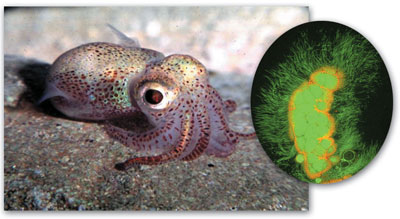 |
There is a relationship based on mutual advantage between the short-tailed squid (Euprymna scolopes) and a light-emitting bacterium (Vibrio fischeri) |
There is a mutually beneficial relationship between the bob-tailed squid (Euprymna scolopes) and luminescent bacteria (Vibrio fischeri), which live in a fold beneath the squid's mantle. This region is known as the squid's luminous organ.
The squid spends its days hidden beneath the sand in shallow waters. When night falls, and it emerges to hunt, the bacteria in its luminous organ begin emitting light. This light enables the animal not to be seen among the night lights and also prevents its enemies from recognizing it. Scientists investigating how the bacteria affected the formation of different tissues discovered that there was a special tissue in the squid's light organ to allow the V. fischeri bacteria to settle inside its body and thus provide an ideal habitat for them. 48
Any light represents a danger for the lantern fish, which also hunts at night. Light will lead to predators identifying the fish, and to let its own prey escape. For that reason, the lantern fish tries not to be visible when there is a lot of artificial light around. When the lantern fish is certain that the night is dark, however, it sets out to hunt down its prey. Its major aid in catching plankton and small crustaceans in the dark is its own light source. The source of the lantern fish's light is semi-circular organs beneath its eyes. These organs are filled with bacteria that emit light, while feeding on oxygen and sugar in the fish's blood.
The fish can turn its light on and off, and can also shine it in the direction it wishes when hunting. This light is so strong that it can be seen underwater from 30 meters (98.43 feet) away. Indeed, the light from a single lantern fish is sufficient to illuminate a small room. These bacteria give off such an effective light that the organ continues to shine even after the fish has been caught and killed. 49
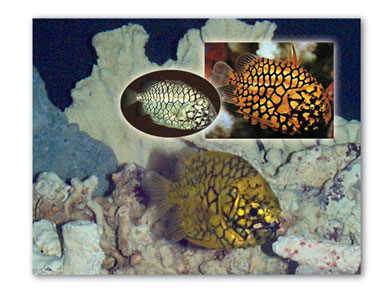 | 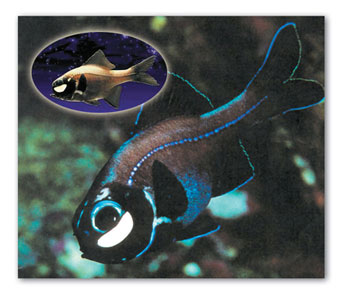 |
Bacteria that settle in the body of the pine cone fish not only find shelter for themselves but also nutrients given off by the fish. In return, they provide the fish with light that helps it hunt at night and find its way. | Light is the greatest helper of the angler fish, which has to hunt in the dark to protect itself from its enemies. The source of this bright light is bacteria under the fish's eyes. |
Another bacterium with the same capacity provides light for the pineapple fish (Cleidopus gloriamaris), which takes its name from the armor-like covered scales covering its body. The bacteria find a suitable place for themselves inside the fish's body. In finding food and shelter for themselves that the fish provides, they emit light that helps the fish to hunt at night and find its way. The same sort of relationship can be seen between bacteria and the pony fish (Leiognathus Nuchalis), which has two glands filled with luminescent bacteria at the rear of its throat. With the help of the bacteria the fish can turn this light on or off when necessary, or else appear totally bathed in light.
Clearly bacteria cannot reason that living inside another species can bring them benefits. Nor can they select an appropriate fish and install themselves in its body, coaxing it to make the needed anatomical changes. Yet what we are dealing with is only a bacterium, and it would be useless to look for the source of this apparent intelligence. Any cooperative system always indicates an intelligence that produced it—namely, the superior mind and might of Allah, Who created it and brought it into being.
Mıcroorganisms of Use to Man
Intestinal Bacteria
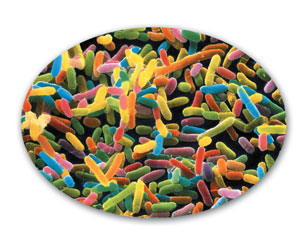 |
The intestinal bacterium Escherichia coli which performs such vital functions in human beings as digestion and the absorption of vitamins. |
Your intestines contain a miniature ecosystem that includes various species of bacteria. Each of these varieties performs a different function, from digesting foodstuffs to absorbing vitamins. The main species of bacteria that dwell in the intestine are known as Escherichia coli. As you have already seen, E. coli possesses around 5,000 genes in a single-helix chromosome. That is the equivalent of around 1 million codons consisting of three letters each.50 (Codons are meaningful "words" consisting of only four letters in the DNA that consists of combinations of the letters A, T, C and G.) In other words, 1 million special codes determine all the bacterium's features and the activities it will perform. The extraordinary quantity and nature of the information carried in E. coli's DNA is expressed in one evolutionist source:
The DNA code is a genetic 'language' that communicates information to the cell. The cell is very complicated, using many DNA instructions to control its every function. The amount of information in the DNA of even the single-celled bacterium, E. coli, is vast indeed. It is greater than the information contained in all the books in any of the world's largest libraries.
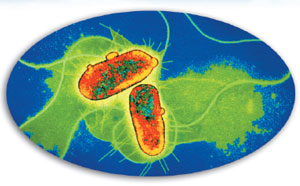 |
The amount of information in the E. coli DNA exceeds that in all the books in the world's biggest library. |
(. . .) E. coli cells, the sequence of letters of its DNA is very specific. Only that particular sequence is capable of biological function. 51
It is not fully known how this bacterium's functions come about, nor whether any benefit accrues to it from this symbiotic lifestyle. But some of these bacteria transmit their requirements to the intestine cells, causing them to secrete sugar, which the bacteria can then use for food. So long as the bacteria are present in the human intestine, they carry out various functions such as digestion and vitamin absorption while preventing other, more harmful species of bacteria from becoming numerous enough to cause sickness. With the help of the bacteria, the intestines gain function, and the immune system is strengthened. In human beings and some mammals, these bacteria also assume the function of vitamin K production which is of the greatest importance because humans and ruminants cannot obtain Vitamin K from the food they eat. Yet the body needs this vitamin, which need is met thanks to these bacteria, which are able to break down and digest the cellulose in the vegetable foods eaten and provide vitamin K for the body. 52
These very complex and vital processes are carried out by bacteria with the same perfection and flawlessness in every human being on Earth. Yet so detailed are these processes that each is a separate indicator of consciousness, whose secrets have not yet been unraveled. The evolutionist magazine New Scientist listed the following mysteries exhibited during the course of bacteria's seemingly conscious behavior:
For decades, this largely benign relationship has had microbiologists scratching their heads. Some of these "commensal"— that is, friendly—bacteria are found only in the mucus that lines the intestine, while others hang out in its various cracks and crevices. How do they know where to go when they colonise the gut in the first hours of an animal's life? And once there, how do they hold their own against the constant influx of new bacteria? And why do some of these Lilliputians live peacefully with us for years, only to turn on us in mean, even deadly, ways? Why, for that matter, isn't the immune system engaged in a constant battle with these intestinal interlopers? 53
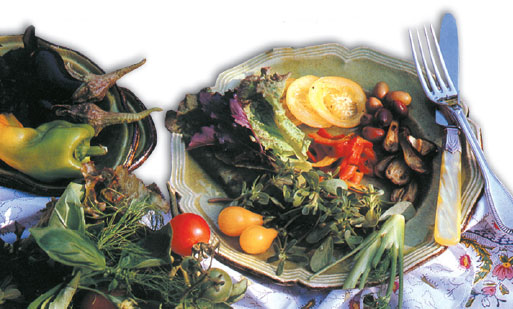 |
Bacteria are able to break down and digest the cellulose living things take into their bodies in vegetables, turn it into glucose and provide the body with vitamin K. It is impossible for the living things in question to obtain vitamin K in any other way. This is an example of Allah's sublime and flawless Creation. |
Another important point to consider is that bacteria are capable of multiplying very rapidly, and when in their environmental conditions are favorable, in a few hours their numbers can quickly rise into the millions. Indeed, the human body is ideally suited to the multiplication of bacteria, which should also multiply excessively and in a very short space of time occupy the entire intestine. Yet such a state of affairs does not apply to the Escherichia coli in the intestine. This bacterium divides in two once every 20 minutes, following which most of the bacteria that multiplied die. Were that not the case, and if E. coli were doubling their numbers every 20 minutes, it would take only 43 hours for them to reaching a volume large enough to cover the entire planet. Yet that never happens, because there is competition for food among the bacteria living there. Those that lose are condemned to starve. In addition, many bacteria are unable to withstand the antibiotics in the body. 54
A bacterial equilibrium is established in the intestines. Those that survive constitute a number necessary for human digestion—a number set out and determined in all human beings for millions of years. Never have all these intestinal bacteria perished or multiplied in an uncontrollably, because these organisms have been specially created to be useful to human beings. Every detail, from their numbers to the functions they perform, is desired and determined by Allah. It is He Who provides this control, and Who plans where, how and at what numbers they should stop.
Bacteria in the Tongue
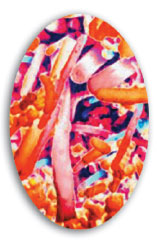 |
How did these bacteria in the picture to the side realize that nitrate is harmful to the body and decide to base themselves in our tongues to eliminate it? Evolutionists can never answer that question. Yet the answer is manifest: These bacteria are obeying a command given them by Allah. |
We take nitrate into our bodies with various foodstuffs. When nitrates enter the body, they lose an oxygen molecule and transform into nitrites. But the ease with which nitrate turns into nitrate is a cause of concern, since nitrites readily enter into chemical reactions and by bonding to amines absorbed with food, turn into a substance known as nitrosamine. (Amines are the general name given to single-value hydrocarbons.) Nitrosamines produced in this way are one of the main causes of serious diseases such as stomach cancer.
 |
The way that bacteria turn nitrate into nitrite in the body is beneficial to us in many ways. Harmful bacteria are removed as the result of nitrite combining with acid in saliva. In other words, this superior production has an antibacterial effect in the body. |
However, nitrosamines—those that sometimes enter the body directly and those that are produced within it—are eliminated before doing any harm, thanks to the bacteria charged with protecting the human body. Researchers recently discovered that 25% of the nitrates absorbed into the body with food returned to the cells in the mouth by mixing with saliva, ready to be turned into nitrite. The reason for this was previously unknown, because nitrite is a potentially harmful substance and there is no advantage for them to be manufactured in the body. Only later was it understood that nitrites combining with the acid in saliva prevents the formation of nitrosamine in the body. But nitrites are also very toxic to various harmful bacteria. Therefore, nitrite was specially returned to our mouths to mix with the food we eat. Food entering our mouths ceased to be harmful, and at the same time, any harmful organisms within it were killed as soon as the food containing them was chewed up.
But where is nitrite produced in the body? Where is it kept? Nitrate is converted into nitrite by bacteria in a region at the back of the tongue where the bacteria are particularly numerous. The bacteria that convert nitrate live in fissures between the taste buds at the back of the tongue, where oxygen cannot reach. Known as facultative anaerobes, these bacteria can live in environments with or without oxygen.
The bacteria also carry out all these processes around the gums, where their activity prevents tooth decay. 55
 |
How do bacteria know that the nitrate we constantly take into our bodies in meat and salads is a potentially harmful substance, and how do they manage to take precautions against this? This is one of the clear proofs that living things were created. |
These chemical processes described so far all take place entirely chemical processes thanks to bacteria. By what decision did the bacteria conclude that the nitrates, whch we constantly ingest with basic foods such as meat and salads, could harm to the human body and then establish a place for themselves to neutralize it? According to Darwinists, it was evolution, or coincidental changes that did this. These bacteria that prevent people from being poisoned and dying from the food they eat took their assigned places by chance during the imaginary process of evolution. Some would have had to live without oxygen due to their location in the body, but that too was resolved by chance!
The immune system in the body would also have to be prevented from regarding all these bacteria as hostile invaders declaring war on them. In some way, chance also eliminated the danger that the immune system would detect anything peculiar about these microorganisms! According to the theory of evolution, chance is the explanation for all these things. Evolutionists describe bacteria's seemingly conscious behavior to protect human beings in terms of evolution, rather than as the result of an intelligent, superior Creation. But in fact, it is absolutely impossible for coincidence to account for the way a bacterium installs itself on the tastebuds at the rear of the tongue, together with all its miraculous features, protecting the body from poisonous substances. Like the human organism itself, this delicate system exists to demonstrate to all those entities capable of reason that there is only one Allah, and there is no other Creator but Him.
This truth is revealed to us in the Qur'an:
He is the First and the Last, the Outward and the Inward. He has knowledge of all things. It is He Who created the heavens and the Earth in six days, then established Himself firmly on the Throne. He knows what goes into the Earth and what comes out of it, what comes down from heaven and what goes up into it. He is with you wherever you are—Allah sees what you do. (Surat al-Hadid, 3-4)
Bacteria That Cause Disease
 |
A bacterium just 1 micrometer (0.000039 inch) in diameter is powerful enough to cause a human being to fall ill and suffer permanent harm. |
The great majority of bacteria are useful to living things, although some possess features that can cause disease and other harmful effects. The ways that a variety of bacteria enters, weakens, or even causes the death of living things many billions of times larger than themselves exhibit a number of intentional stages, each with many details of its own. Indeed, a great many illnesses are caused by bacteria. Despite being only 1 micrometer (0.00003937 of an inch) in diameter, invisible to the naked eye, how can bacteria have such powerful effects?
Harmful bacteria generally reach humans and animals through their foods. You know how quickly bacteria multiply once they find a suitable environment. Nutrients like the proteins and factors such as moisture constitute an appropriate environment for them to multiply in foodstuffs. Some bacteria are harmless on their own, but when begin to reproduce in food, they start secreting poisonous toxins, which then lead to food poisoning.
When we consume food containing these bacteria, these organisms continue to reproduce in our intestines. The toxin that produced in the region of the cell where they settle can result in the death of the cell and spread through the digestive system. Infection thus appears in the intestines. In some situations, bacteria can leave toxins on foodstuffs without actually entering the body themselves. When the food is eaten, its toxins are absorbed into the body, and serious food poisoning may again ensue. 56
One of the dread diseases caused by bacteria is known as:
Plague: Against Which Mankind Was Powerless for Centuries
People can be poisoned by bacteria in the food they eat. Yet bacteria can also have other harmful effects. The most important feature of the bacterium that goes by the name of coccobacillus is that it was the sole cause of the plague that killed almost a third of the population of Europe in the 14th century.
How is it that this microorganism decided to have such an deadly effect en masse and invade so many bodies? Darwinists, who seek to deny Allah's creative power, can clearly see their own helplessness in the face of this tiny microorganism that He created, and in the face of His great might.
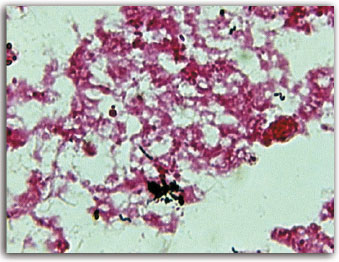 |
The bacterium coccobacillus that caused vast numbers to die from bubonic plague. |
The plague bacterium lives parasitically in rodents like rats, mice and squirrels, and is passed on to humans by these animals' fleas. Surrounded by the immune system in the human intestine, the bacterium has a simulating and cell-multiplying effect. The plague bacterium enters the human body through the skin, eyes, mouth, digestive tract, respiratory passage, blood and lymph glands.
In the skin, where the bacterium first enters, sacs and nodules form. These represent the body's first resistance displayed towards the bacteria, but the body is unable to withstand them for long. The bacteria and the toxin they form enters the lymph glands through the lymph canals. Where the bacteria have settled in, the lymph glands begin to swell up, causing edemas to form around the lymph glands. As the lymph glands fill up with the bacterial toxin, gangrene then develop, causing the specific tissue to die and begin to decay. At this point, some plague bacteria can enter the bloodstream, reaching the spleen, liver, and other internal lymph glands, all of which then start to swell. As a result, other organs and lymph nodes fail, and death follows. 57
All this results from the multiplication of a single cell, which we can only observe under a microscope. The microorganism can destroy a body that it occupies in stages. In fact, apart from a few experimental vaccinations, still at the research stage, no sure precaution against plague has yet been discovered. As yet, these vaccinations cannot prevent problems experienced in the intestine, digestive or respiratory systems.
In addition to these, plague bacteria have been discovered that carry genes resistant to five different antibiotics.58 In short, no matter what solutions are found, these bacteria will continue to exhibit resistance to the remedies. In other words, this microorganism constantly develops its own immunity, preparing itself to create ever worse problems, and clearly behaves with the same intelligence as that of human beings.
Overcoming all these difficulties is a major difficulty for Darwinists who, refusing to recognize the might of Allah, place themselves at the center of all things and regard themselves as all-powerful, seeking to convince others of the nonsense that everything came into being by chance. The way that one single bacterium can put an end to human life, and can function so efficiently and systematically as to leave medical science with no answers, clearly indicates the existence of an omniscient Creator. No scientific study has ever offered any other explanation. Those carried out in the future will also fail to produce results, and every new detail discovered will again reveal a superior and flawless Creation. Like everything else, this bacterium behaves under the inspiration of Allah, and obeys no one but Allah.
Intelligent Invaders of the Stomach
This organ has been specially created to grind up and break down foodstuffs. The gastric acid secreted in the stomach is powerful enough to dissolve razor blades. Every foodstuff entering the stomach is therefore dissolved with the help of these acids.
Researches into the causes of peptic ulcers that form in the stomach showed that they were caused by a bacterium known as Helicobacter pylori. How is it able to survive in such a strongly acidic environment? The bacterium eliminates the problem with an exceedingly rational system—by establishing a shelter within this highly dangerous environment. The stomach employs a mucosal layer to prevent its being damaged by its own acid. And just as if they were consciously aware that the acid presented a grave danger, the bacteria hide inside this layer. In order to do so, of course, they first need to realize that the stomach possesses such a protective layer, and they must anticipate that if they settle in that same environment, they will come to no harm.
The bacterium secretes an enzyme known as urease that makes its environment suitable to live in. This enzyme converts urea into ammonia—an important conversion, because the resulting ammonia buffers the level of acid where the bacteria are present, and it ceases to be potentially lethal.
Once this deadly effect has been eliminated, the bacterium begins secreting its own toxic substances, whose purpose is to neutralize the immune system in the region. Conditions are now suitable for the bacterium to thrive. It begins to reproduce and spread the disease.
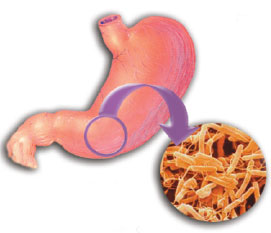 |
When the cause of stomach ulcers was investigated a bacterium known as Helicobacter pylori was shown to be responsible. |
In fact, why do these bacteria seek to invade such a dangerous region of the body? Reasonably, the bacterium could have infected any area underneath the mucosal layer, instead of this perilous zone. That would not only be easier to do, but would avoid possibly fatal hazards. But the bacterium elects not to do this, so how does it obtain nourishment here?
When the stomach's mucosa become infected, the body dispatches to the region large numbers of defense cells and nutrients. This flow continues as long as the infection persists, providing a constant flow of nourishment that the bacteria need. That is why the bacterium prefers this region of the body, despite all its dangers. You can clearly see that this bacterium has performed a calculation. Right from the outset, it considers that the body will send quantities of nutrients to the areas it infects. Who provided it with that information? How can it surmise that the stomach possesses such a defense mechanism? Assuming that they do make such a surmise, how have they become able to use this information? Those who are unaware of Allah's might will seek distorted answers to these questions and will never be able to obtain any results. That is because Almighty Allah has no partners in His Creation and creates without previous models. We need to appreciate His hand in all these works in order to understand His matchless artistry.
Say: "Travel about the Earth and see how He brought Creation out of nothing. Then later, Allah will bring about the next existence. Allah has power over all things." (Surat al-‘Ankabut, 20)
Bacteria can also cause many other serious and deadly diseases, including leprosy, meningitis, tuberculosis, cholera and typhus. In all these diseases, the bacteria with a different DNA structures invade the body through intentional actions These diseases, and many others like them, are caused by a single-celled organisms that as yet can be cured only with difficulty, or not at all.
Bacteria Become Immune to Antibiotics
You realize that most of the bacteria that enter the bodies are useful or harmless, while a few others can give rise to diseases. The only way of getting rid of disease-causing bacteria that the immune system can't defeat is by the use of antibiotics. Some of the antibiotics administered in various ways kill bacteria, while others impede their development and reproduction. For example, some antibiotics target the bacterium's cell membrane, preventing it from forming a sheath to protect it from external influences. Fluid thus accumulates in the cell, which eventually bursts and is neutralized.
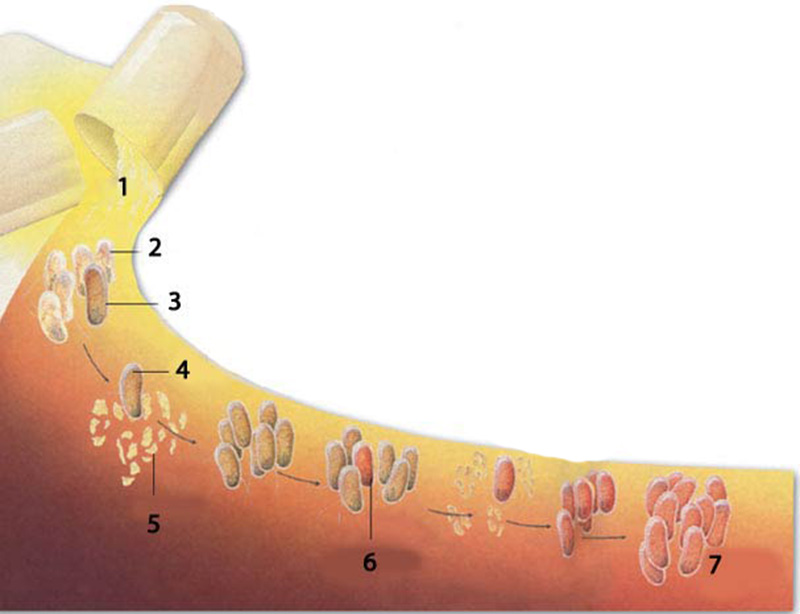 | |
1. Antibiotic, | 5. Dead bacterium, |
The picture shows how as some bacteria are eliminated by antibiotics others acquire resistance and continue to multiply. | |
Having done its job, an antibiotic leaves to the body's immune system the business of clearing away the dead bacteria. For example, some antibiotics target the bacterium's cell membrane. These antibiotics prevent the bacterium forming a sheath that will protect it from external influences. Fluid thus accumulates in the cell, which eventually bursts and is neutralized.
 | |
1. The antibiotic hells, | 4. Non-resistant bacteria, |
When antibiotic therapy comes to an end, resistant bacteria once again exhibit resistance. If bacteria without resistance to the antibiotic are nearby they take in the resistant bacterium and weaken it. | |
On the other hand, some antibiotics, change the levels of vital substances that enter and leave the bacterium. As we know, a cell membrane possesses selective permeability that allows beneficial substances to enter the cell, while harmful substances are recognized and excluded, while wastes are expelled. The antibiotic alters this special selective permeability in the bacterium's cell membrane. A bacterium that is unable to absorb nutrients, but which harmful substances can freely enter, soon dies. Still other antibiotics target bacterial proteins. Proteins perform cells' vital functions. Therefore, when proteins are absent these functions cannot be carried out, and the death of the bacterium is inevitable. The ribosome in the cell produces proteins. The antibiotics decelerate protein production by impairing the ribosome system, even causing the wrong proteins to be manufactured. Another antibiotic prevents the production of nucleic acids, which are again necessary for protein formation.59 The bacterium again dies from lack of proteins when nucleic acid is not manufactured.
Antibiotics can protect us against harmful bacteria, but only if the structure of the bacterium under normal conditions is known, and an appropriate antibiotic can be manufactured. This is by no means as easy as you might think. Bacteria employ various tactics and ways of defending themselves against antibiotics. These microorganisms, only a few microns in size, react in a seemingly intelligent manner and can display resistance to antibiotics, produced by countless human beings using the most advanced technology under laboratory conditions, by altering their own genes within a matter of seconds.
How Do Bacteria Defend Themselves?
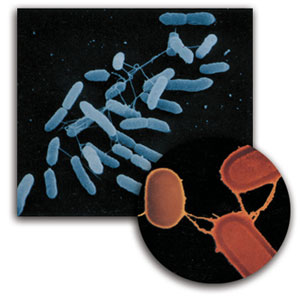 |
Bacteria change their own genetic structure in order to exhibit resistance to antibiotics. They then transmit the genes concerned to other individuals by way of bridges for the survival of the whole community. |
How did a microorganism consisting of only a few organelles, a cell membrane, DNA and a ribosome, protect itself against antibiotics? How does it determine those elements that represent a danger and develop protective measures against them? It's of course out of the question to speak of such an organism's consciousness, ability or comprehension. There must be a satisfying and rational explanation for the behavior it manifests in its war against antibiotics. In order to see and appreciate the source of this intelligence let us first examine the nature of bacteria's resistance to antibiotics.
When an antibiotic enters the body, some species of bacteria multiply as fast as possible. Those unable to withstand the antibiotic are defeated and die. Those which do exhibit resistance to the antibiotic continue reproducing, and produce new, resistant generations. Therefore, any antibiotic introduced into the body is usually insufficient to eliminate them all and is not strong enough to destroy the new, resistant strains. As a result, the disease will persist even in the presence of the appropriate drug.
A second method employed by bacteria consists of changing by altering their genetic structure. Having already encountered the antibiotic, the bacterium knows how the antibiotics will disable it, then makes genetic changes in those sites that the antibiotics will affect. For example, it may begin producing new molecules that affect its cell membrane. Thus in subsequent encounters, the antibiotics will meet resistance from these freshly manufactured molecules and be unable to affect the cell wall.
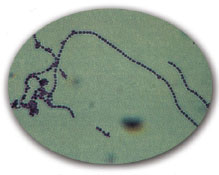 |
The bacterium Streptococcus magnified 900 times |
Another conscious strategy is that bacteria prevent the drug from entering the cell wall, either by pumping the drug out again or else by preventing it from entering at all. Of course, genetic changes for such an action also need to be carried out, yet bacteria are able to do this with ease.
Another means of bacterial self-defense is to alter the site where the antibiotic should bind. Since the antibiotic cannot reach the site it must attach to under normal conditions, it will be unable to neutralize the bacterium. We still do not know how bacteria acquire the genes necessary for such a change.
Bacteria can also make resistant the regions that the antibiotic will target. Some streptococci can only survive in the presence of a molecule known as thymidine. If an antibiotic prevents the streptococcus from producing thymidine, the bacterium defends itself by producing thymidine in a different way. The antibiotic cannot halt the production of thymidine in unexpected way, so will be unable to kill the bacterium.
Another proof that bacteria behave in a conscious manner is the way that the knowing teach the unknowing. A bacterium that succeeds in exhibiting resistance by changing its genetic structure may be able to pass along to other members of its own species the genes that allow this change. To do this, two bacteria construct a bridge between them, and pass the relevant gene from one to the other.
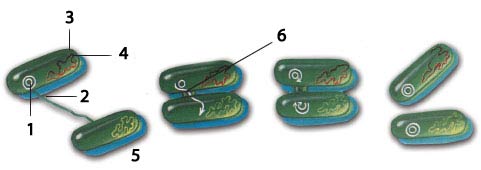 | |
1. Plasmid, | 4. Bacterium chromosome, |
The bridge and gene transmission established by two bacteria in order for them to survive | |
Another method is for a bacterium to eject its helix-shaped DNA into the environment, for others to include in their own genetic codes. These helix-shaped DNA fragments are known as plasmids. Any one bacterium can develop resistance to more than one antibiotic with just a single plasmid.60 This method that bacteria employ is the most feared by medical circles and constantly prevents the conquering of diseases. A disease that was formerly eradicated with a given antibiotic assumes a new virulence because the bacterium alters its genetic structure and is no longer vulnerable.
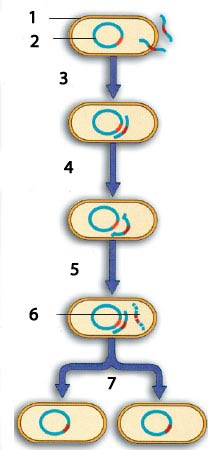 |
1. Bacterium cell, |
Certain bacteria make changes in their genes in order to exhibit resistance to antibiotics and later deposit their DNA in their surroundings. Other bacteria then include these DNA particles in their own genes and acquire resistance. |
No doubt that Allah has endowed this organism invisible to the naked eye with a strategy superior to those of human beings. Through Allah's inspiration, a bacterium can identify developments that humans did not notice or even guess at, and can react more promptly than them.
Human themselves are aware of this. Years of research have been employed to find solutions to overcome the tactics of a single bacterium.
Evolutionists have widely used this characteristic of bacteria to confirm their theory. In their view, the way that bacteria develop resistance to certain antibiotics, and the way that some insects develop immunity to pesticides confirm the process of evolution. But what we are really dealing with changes within a single species. Not the Creation of any new ones.
As you know, mutation occupies a vital place in the basic mechanism of change proposed by evolutionists. According to their claim, as a result of various internal and external effects, random changes taking place in the DNA sequence and cause new species to emerge over the long run. In fact, mutations take place in the DNA sequence, but most of these known mutations are harmful. They inflict damage on the new organism, while the other mutations wield no effect at all. However, evolutionists still believe that useful mutations sometimes occur, and that thanks to them, new species arise. (For detailed information, see Harun Yahya's, Darwinism Refuted, Goodword Books Pvt. Ltd., 2002.) Evolutionists believe that bacteria develop resistance to antibiotics by undergoing useful mutations, and therefore offer an important verification of evolution. However, such a conclusion stems from evolutionists' own ideological tendencies. When examined in detail, the way bacteria acquire resistance to antibiotics can never constitute evidence of the theory of evolution.
1.All known antibiotics were obtained from microorganisms that already existed in nature, living things produce substances that can kill and break down different bacteria. Some microorganisms, however, possess genes that permit them to mount a defense system inside their bodies against these sorts of antibiotics, ready to withstand the deadly substance inside the antibiotic. The gene packet in which this defense mechanism's data are concealed can be shared between bacteria. For example, if one bacterium has a gene to defend itself against flu vaccine, this bacterium leaves in the environment packages or plasmids, which computer enthusiasts may compare to compact discs. Other bacteria can take up this information and assemble it in their own data banks, or DNA. In this way, different bacteria can acquire the same defense against the flu vaccine. No stage that could offer evidence for evolution occurs during this process. The bacterial DNA does not experience a random mutation and acquire any new characteristic. It has possessed the information that permits it to exhibit resistance ever since it was first created. The fact that genetic research has determined no difference, between specimens of bacteria that lived hundreds of millions of years ago and living ones is a major proof of this. The sharing of this information with other bacteria proves not that the bacteria evolved by chance, only of the perfect mechanism created for the exchange of this information.
 |
Various antibiotics are produced in the present day that hinder the expert invader methods used by bacteria. However, despite advanced technology, antibiotic therapy methods are unable to keep pace with bacteria's self-defense techniques. |
2.Bacteria that are resistant to antibiotics survive; those without resistant genes die, but no truly new species emerges. Since only non-resistant bacteria die, bacteria with resistance multiply into a more numerous strain of the same bacterium. The proponents of Darwinism refer to this change as "micro-evolution" and claim that this constitutes a small step in the large-scale speciation known as macro-evolution. However, as you can see, bacteria handing on antibiotic-resistant genes to other bacteria is not an evolutionary mechanism. In order for this to constitute evidence for evolution, this exchange would have to add new information to the organism's DNA. Yet as the result of exchange, the bacterium does not acquire immunity. The resistance already exists within its DNA.
3.In all the mutations evolutionists put forward as beneficial, the mutation has actually caused the organism to lose information, and become damaged. Evolutionists have therefore found themselves in a major impasse in trying to explain how mutations add useful information to the data bank of DNA. The fact that bacteria possess such features is a major cause of concern in the doomsday scenarios recently drawn by scientists such as Stephen Hawking. The way that disease-causing bacteria acquire resistance to different antibiotics increases the possibility of the emergence of a super-bacterium.
Evolutionists' Error Regarding Bacteria
 |
A single bacterium, the size of which is measured in microns, can develop instantaneous and expert solutions to all the precautionary measures it takes human beings years to find. This fact poses a major dilemma for evolutionists, who believe in coincidences. |
According to Darwinists, life emerged thanks to when first bacterium came into being by chance. In order to be able to claim that it suddenly began metabolizing in a totally uncontrolled environment, they suggest that it must have been simple. This allegedly simple life form had to be randomly affected by various environmental conditions, experience various random changes, learn various miraculous features—such as producing its own nutrients, suddenly beginning to divide itself in two— and to come to constitute the wide-ranging spectrum of present-day life.
According to the theory of evolution, there must have been an imaginary simple bacterium in order for life to have a beginning. According to that same superstitious belief, all living things evolved from simpler forms and gradually became more complex. This view has generally prevailed in the taxonomy, or classification, of living things. Today, however, the enormous strides in the world of science have led to a change in that understanding and exposed the theory of evolution coming in for strong criticism. The late evolutionist Stephen Jay Gould emphasized the racism that underlies the view that humans are superior to all other living things, and that one race of humans is regarded as superior:
In folk taxonomy, it merely leads us to make fine distinctions among creatures close to us and very broad ones for more distant, "simple" organisms. Every novel bump on a tooth defines a new kind of mammal, but we tend to lump all single-celled creatures together as "primitive" organisms." 61
The claim that life began thanks to a simple first bacterium is a major deception. Those who claim that must first explain how life came into being. Evolutionist sources, however, present no scientific findings on how life first emerged. This absence of scientific evidence has led to various speculation and myths being regarded as valid. The materialist perspective at the basis of the theory has played an important role in the formation of these tall tales.
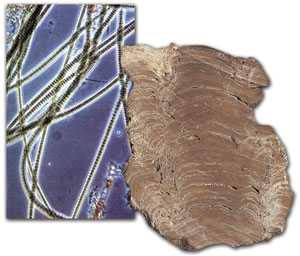 |
his stratum, dating back to the early Archaic period and formed by the activities of cyanobacteria shows that bacteria were performing complex processes such as photosynthesis millions of years ago. |
According to the fossil record, the first known living thing was a cyanobacterium that lived some 3.5 billion years ago. This bacterium is still alive today, having undergone no changes. The real disappointment for evolutionists, however, is that it is one of the most complex bacteria known! This cyanobacterium, with a capability to perform photosynthesis, is definitely not regarded as a simple form of life by modern-day scientists. It is at this point that the evolutionist claim suffers a major defeat. The fossil record shows that bacteria of 3.85 billion years ago had the same properties as they do today. Researches have shown that the Earth's becoming able to sustain life dates back to exactly those times.62 In other words, the complex structures of bacteria that we'll discuss in later chapters emerged not through impossible gradual coincidences, through a long process of trial and error, but suddenly—as the specific component of a superior plan.
Furthermore, the sudden coming to life from a state of lifelessness, is impossible, no matter how simple an entity may be. No natural mechanism has the power to produce animate matter from inanimate. Even if water, soil and air remain combined for billions of years, they still lack the directed consciousness to produce life, or attain the superior structure that life requires. Viewed from that perspective, bacteria are not in fact simple organisms at all, as evolutionists would have us believe, as you can see in evolutionist calculations regarding the chances of a bacterium's emerging spontaneously:
Hoyle and Wickramsinghe, who estimated the odds of spontaneous generation of a living bacterium at 1040.000'to 1... Shapiro then cites Morowitz who made estimates based on more realistic conditions. A more realistic estimate has been made by Harold Morowitz...The answer computed by Morowitz reduces the odds of Hoyle to utter insignificance: 1 chance in 10100.000.000.000...63
To examine the mathematics a little more closely, we must place 100 billion zeroes after the number 10 and to accept that unbelievably huge figure as a probability. Yet in mathematics, probabilities smaller than 1050are regarded as zero. In short, it's impossible for such am unlikely probability to occur.
 |
Bacteria demonstrate their effects not just in human beings, but in all life, from a termite living underground to the root fibers of a plant. With the many activities they perform, these microorganisms are one of the basic elements of life. The way they constitute an essential component of life is one of the signs of Allah's superior Creation. |
All this clearly shows that bacteria are by no means simple in terms of their structure and function. If evolutionists regard single-celled bacteria as simple stems, solely based on the ideology to which they are so devoted. These creatures need to possess such a complex structure to fulfill the vital functions they assume, and employ specialized structures to perform their particular tasks.
Take bacteria that perform photosynthesis as an example. These creatures produce 70% of the oxygen necessary for life, while using carbon dioxide to produce food that could not emerge in any other way. Thanks to this superior organism that evolutionists describe as simple, free oxygen and the basis of the world's entire food chain emerge, and the level of the toxic carbon dioxide in the atmosphere is regulated, and the systems in these creatures capable of reproducing very quickly and in very large numbers produce foods consumed by themselves and other organisms. In addition to all these properties, the structures of single-celled organisms such as algae, plankton and diatoms may be compared to computer chips, marvels of superior technology, making the idea that they are simple totally ridiculous.
Bacteria demonstrate their effects in all living things, from termites to the roots of plants, having spread all over the world and been performing their tasks to the letter for billions of years. All of which points to one single truth: Creation.
The adherents of evolution are very aware that these organisms' structures are not simple at all. Therefore, they find themselves in a constant quandary in seeking to account for the mechanisms they possess. The theory of evolution hesitates to confront the science and technology that registered such enormous progress in the 20th century, because the new world revealed under the electron microscope once again gave the lie to Darwin's theory. Let evolutionists keep on looking for an other explanation, but every new feature we discover in these living things will be a means of appreciating how Allah has created flawless artistry in organisms invisible to the naked eye. This flawless artistry and knowledge of Allah's is expressed in the following terms in the Qur'an:
Praise be to Allah, to Whom everything in the heavens and everything in the Earth belongs, and praise be to Him in the Hereafter. He is the All-Wise, the All-Aware. He knows what goes into the Earth and what comes out of it, and what comes down from heaven and what goes up into it. And He is the Most Merciful, the Ever-Forgiving. (Surah Saba', 1-2)
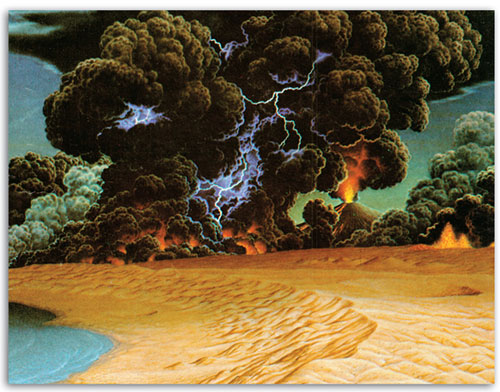 |
According to evolutionists, life took shape with the emergence of a first primitive bacterium in the so-called primordial atmosphere. The discovery that bacteria are in fact very far from being primitive totally undermined all evolutionists' claims. |
Footnotes
3- L.M.Prescott- J.P.Harley- D.A.Klein, Microbiology, McGrawHill, International, 1999, sf. 13
4- http://www2.ntu.ac.uk/life/sh/modules/hlx202/Lectures/Lecture1.htm
5- Michael Denton, Evolution a Theory in Crisis, Burnett Bokks, USA, 1985, sf. 224-225
6- Büyük Larousse Sözlük ve Ansiklopedisi, Cilt 3, Milliyet, İstanbul, 1986, sf. 1237-1238
7- James A. Shapiro, Bacteria as Multicellular Organisms, Scientific American, Vol. 258, Haziran 1998, sf. 82
8- Michael Denton, Evolution a Theory in Crisis, Burnett Books, USA, 1985, sf. 264
9- Sir James Gray, The Science of Life, chapter in Science Today, 1961, sf. 21
10- Mahlon B. Hoagland, Hayatın Kökleri, Tübitak, Ankara, 1998, sf. 25
11- http://www.pathlights.com/ce_encyclopedia/08dna02.htm
12- http://www.bact.wisc.edu/microtextbook/bacterialstructure/DNA.html
13- Loren Eiseley, The Immense Journey, 1957, sf. 206 (Alman Biyolog Von Bertalanffy'dan alıntı) - http://www.pathlights.com/ce_encyclopedia/08dna05.htm
14- Dr. Lee Spetner, Not By Chance, Shattering The Modern Theory of Evolution, The Judaica Press, New York, 1998, sf. 30
15- L. Cohen, Darwin Was Wrong, 1984, sf. 205
http://www.pathlights.com/ce_encyclopedia/08dna04.htm
16- Joseph W. Francis, Peering into Darwin's box: The Cell Division Processes Required for Bacterial Life, Origin & Design 20:1, issue 38,
http://www.arn.org/docs/odesign/od201/peeringdbb201.htm
17- Eshel Ben-Jacob, Herbert, The Artistry of Microorganisms, Scientific American, Ekim 1998
18- Zuhal Özer, Yeryüzünün Başarılı Kimyacıları Bakteriler, Bilim ve Teknik, Ocak 1997, sf. 65
19- Büyük Larousse Sözlük ve Ansiklopedisi, Cilt 3, Milliyet, İstanbul, 1986, sf. 1237-1238
20- Zuhal Özer, Yeryüzünün Başarılı Kimyacıları Bakteriler, Bilim ve Teknik, Ocak 1997, sf. 65
21- Guy Murchie, The Seven Mysteries of Life, Houghton Mifflin Company, Boston, 1978, sf. 84
22- Lynn Hunt, Send in the Clouds, New Scientist, vol 158, 30 Mayıs 1998, sf. 28
23- Joanna Marchant, Life in the Clouds, New Scientist, vol 167, 26 Ağustos 2000, sf. 4
24- Zuhal Özer, Yeryüzünün Başarılı Kimyacıları Bakteriler, Bilim ve Teknik, Ocak 1997, sf. 63
25- http://www.selby.org/research/canopy/whatisphotosynthesis.html
26- Ali Demirsoy, Kalıtım ve Evrim, Meteksan Yayınları, Ankara, 1984, sf. 80
27- Selçuk Alsan, Dünyada Ne Kadar Mikrop Var?, Bilim ve Teknik, Temmuz 1999, sf. 90
28- http://helios.bto.ed.ac.uk/bto/microbes/nitrogen.htm,
http://www.ultranet.com/~jkimball/BiologyPages/N/NitrogenFixation.html
29- M.J. Pelczar, E.C.S.Chan, N.R.Krieg, Microbiology Concepts and Applications, McGraw-Hill, ABD, 1993, sf.790
30- Philip Bal, Bugs Offer Power Tips, Nature, 8 Ekim 2001
31- H.Curtis, N.S.Barnes, Invitation to Biology, Worth Publishers, New York, 1985, sf. 354
32- Zuhal Özer, Yeryüzünün Başarılı Kimyacıları Bakteriler, Bilim ve Teknik, Ocak 1997, sf. 62
33- Prof. Dr. Tümer Uraz, AÜ Ziraat,
http://members.fortunecity.com/bilgistan/bilim/p_biyotik2.html
34- Guy Murchie, The Seven Mysteries of Life, Houghton Mifflin Company, Boston, 1978, sf. 362
35- Michel Magot, Petrol Yatağı Bakterileri, Bilim ve Teknik, Temmuz 1995, sf. 69
36- http://nrg.ncl.ac.uk/research/publications/2001/2001abs10.html
37- http://scrippsnews.ucsd.edu/releases2001/staudigel_rockeaters.html
38- M.J. Pelczar, E.C.S.Chan, N.R.Krieg, Microbiology Concepts and Applications, McGraw-Hill, ABD, 1993, sf. 814
39- John Downer, Supernature, The Unseen Powers of Animals, Sterling Publishing Company, New York, 1999, sf. 136
40- John Downer, Supernature, The Unseen Powers of Animals, Sterling Publishing Company, New York, 1999, sf. 137
41- Selçuk Alsan, Dünyada Ne Kadar Mikrop Var?, Bilim ve Teknik, Temmuz 1999, sf. 90
42- İnsan Vücudunun Davetsiz Konukları, Cumhuriyet Bilim ve Teknik, 28 Ekim 2000, sf. 23
43- İnsan Vücudunun Davetsiz Konukları, Cumhuriyet Bilim ve Teknik, 28 Ekim 2000, sf. 23
44- Garry Hamilton, Insider Trading, New Scientist, Vol. 162, 26 Haziran 1999, sf. 44-45
45- http: //www. chm.bris.ac.uk /motm/ttx/ttxv.htm
46- John Downer, Supernature, The Unseen Powers of Animals, Sterling Publishing Company, New York, 1999, sf. 132
47- http://wy.essortment.com/whatisatubew_rkxn.htm, http://www.remineralize-the-earth.org/magazine/CompostRecycling/Vermiculture.html
48- Garry Hamilton, Insider Trading, New Scientist, Vol. 162, 26 Haziran 1999, sf. 44
49- Anitia Ganeri, Creatures That, Victor Gollancz Press, London, 1995, sf. 12
50- http://www.pathlights.com/ce_encyclopedia/08dna03.htm
51- http://www.origins.org/offices/thaxton/docs/thaxton_dna.html – DNA, Design and The Origin of Life / Charles B. Thaxton, Ph. D.
52- Garry Hamilton, Insider Trading, New Scientist, Vol. 162, 26 Haziran 1999, sf. 43
53- Garry Hamilton, Insider Trading, New Scientist, Vol. 162, 26 Haziran 1999, sf. 43
54- Zuhal Özer, Yeryüzünün Başarılı Kimyacıları Bakteriler, Bilim ve Teknik, Ocak 1997, sf. 64
55- Sarah Richardson, Dildeki Bakteriler, Bilim ve Teknik, Mart 1996, sf. 49
56- Gülgün Akbaba, Dikkat! Sağlığımızda ve Cebimizde Gözü Olanlar Var, Bilim ve Teknik, Mart 1994, sf. 35
57- Gülgün Akbaba, Bir Salgının Öyküsü, Bilim ve Teknik, Nisan 1999, sf. 100-101
58- Gülgün Akbaba, Bir Salgının Öyküsü, Bilim ve Teknik, Nisan 1999, sf. 101
59- Didem Sanyel, Zaferi Biz mi, Süper Mikroplar mı Kazanacak? Antibiyotik Direnci, Bilim ve Teknik, Mart 1999, sf. 36
60- Didem Sanyel, Zaferi Biz mi, Süper Mikroplar mı Kazanacak? Antibiyotik Direnci, Bilim ve Teknik, Mart 1999, sf. 37
61- Stephen Jay Gould, Darwin ve Sonrası Doğa Tarihi Üzerine Düşünceler, Tübitak, Ankara, 2000, s.113
62- John Horgan, Life, Life Everywere, Scientific American, Kasım 1996
63- Stephen Jones, Crichton, evolution and Chaos, http://asa.calvin.edu/archive/evolution/199505-10/1515.html
